Abstract
Azomethine ylides are nitrogen-based three-atom components commonly used in [3+2]-cycloaddition reactions with various unsaturated 2π-electron components. These reactions are highly regio- and stereoselective and have attracted the attention of organic chemists with respect to the construction of diverse heterocycles potentially bearing four new contiguous stereogenic centers. This review article complies the most important [3+2]-cycloaddition reactions of azomethine ylides with various olefinic, unsaturated 2π-electron components (acyclic, alicyclic, heterocyclic, and exocyclic ones) reported over the past two decades.
1. Introduction
The three-atom component (TAC) is an organic species that is represented by zwitterionic octet structures and undergoes [3+2]-cycloadditions with an unsaturated 2π-electron component in a one-step reaction, often in an asynchronous and symmetry-conducive fashion, via a thermal six-electron Hückel aromatic transition state. The formal charges are lost in the [3+2→5] cycloaddition (Figure 1) [1]. Recently, studies based on molecular electron density theory (MEDT) have suggested that the compounds involved in these reactions do not have a polar nature but a diradical, pseudoradical, or carbenoid nature. Therefore, the use of the term “1,3-dipole” is unjustified and should be replaced with “three-atom component”. It was also recommend that the designation of “dipolarophile” should be replaced with “unsaturated 2π-electron component”, and “1,3-dipolar cycloaddition” with “[3+2]-cycloaddition” [2].

Figure 1.
Historical Huisgen’s view on the [3+2]-cycloaddition reaction.
While there is a mechanistic spectrum of this reaction from a synchronous one-step process to a stepwise overall transformation (including radical pathways), to avoid mechanistic digressions that may not have chemical or stereochemical consequences, in this synthetic review article, we will refer to the azomethine ylide reaction as a pericyclic cycloaddition. [3+2]-Cycloadditions of azomethine ylide with homomultiple and heteromultiple unsaturated 2π-electron components have been extensively used to produce a wide range of heterocycles [3]. There are several methods for the formation of azomethine ylides, including the thermolysis or photolysis of readily prepared aziridines, the dehydrohalogenation of immonium salts, and proton abstraction from imine derivatives of α-amino acids [3]. They are often generated in situ because of their high reactivity and/or transient existence; however, in some cases, stabilized ylides have been isolated and used further [4,5,6].
The synthesis of five-membered heterocyclic systems through azomethine ylides is one of the most adopted, efficient, and powerful approaches. Since the first report of successful the enantioselective [3+2]-cycloaddition of an azomethine ylide in 1991 [7], there has been tremendous progress in the chemistry regarding azomethine ylides. Azomethine ylides are extensively used in the synthesis of various heterocyclic systems such as pyrrolidines, pyrrolizidines, indolizidines, piperidines, oxazolidines, spiroindoles, spiropyrrolidines, and spiropiperidines, but they are also used for the total synthesis of complex natural products as well as bioactive compounds [8,9,10,11,12,13,14,15]. In recent years, the [3+2]-cycloaddition reaction has been extensively studied for the synthesis of heterocycles using different synthetic strategies [16,17]. In addition, the reaction is also investigated to understand the related reactivity, reaction conditions, intermediates, etc. [18,19].
This review article deals with the [3+2]-cycloaddition reaction of azomethine ylides with an unsaturated carbon–carbon bond (in either acyclic, alicyclic, heterocyclic, or exocyclic systems) that leads to the formation of pyrrolidinyl-containing analogs reported in the last two decades and their biological applications. This review article is intended to be a critical resource for the researchers involved or interested in azomethine ylides-mediated heterocyclic synthesis. It is also hoped that this review article will inspire chemists in this area of research.
2. Acyclic Unsaturated 2π-Electron Components
2.1. Intermolecular Cycloaddition Reaction of Azomethine Ylides to Acyclic Unsaturated 2π-Electron Components (Alkenes)
Unstabilized azomethine ylide 2 derived from benzyl(methoxymethyl)(trimethylsilylmethyl)amine 1 undergoes a [3+2]-cycloaddition reaction with electron-deficient alkenes 3 under continuous flow conditions in the presence of catalytic trifluoroacetic acid, thereby affording the corresponding pyrrolidines 4 (Scheme 1) [20].

Scheme 1.
Synthesis of pyrrolidines 4.
Azomethine ylides generated via the deprotonation of α-imino-esters 5 undergo a [3+2]-cycloaddition reaction with unsaturated 2π-electron components 6 in the presence of the eco-friendly supported solid-base catalyst KF/Al2O3 to yield the corresponding pyrrolidines 7 with high regio- and diastereoselectivity (Scheme 2) [21].

Scheme 2.
Synthesis of pyrrolidines 7.
Belfaitah et al. reported the cycloaddition reaction of azomethine ylides 9 with alkenyl boronates 8 to obtain the 3-boronic-ester-substituted pyrrolidines 10 (Scheme 3) [22].
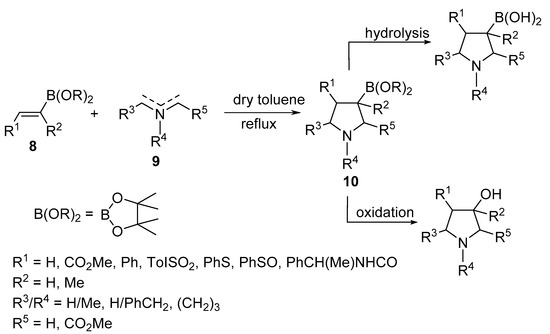
Scheme 3.
Synthesis of 3-boronate pyrrolidines 10.
Pyrrolo[2,1-a]isoquinolines 15 were obtained through a sequential one-pot, two-step tandem reaction of isoquinoline 11, α-halogenated methylenes 12, aromatic aldehydes 13, and cyanoacetoamide 14 in the presence of triethylamine as a basic catalyst and 2,4-dichloro-5,6-dicyano-1,4-benzoquinone (DDQ) as an oxidizing agent. The transformation was assumed to take place through [3+2]-cycloaddition of N-substituted carbonylmethyleneisoquinolinium bromide (formed via the reaction of isoquinoline 11 and 12) with arylidene cyanoacetamide (formed via the condensation of cyanoacetamide 14 with aromatic aldehyde 13) [23]. In the case of the ethyl bromoacetate 16 derivative, the formation of pyrrolo[2,1-a]isoquinolines 17 was observed probably due to DDQ oxidation (Scheme 4) [23].
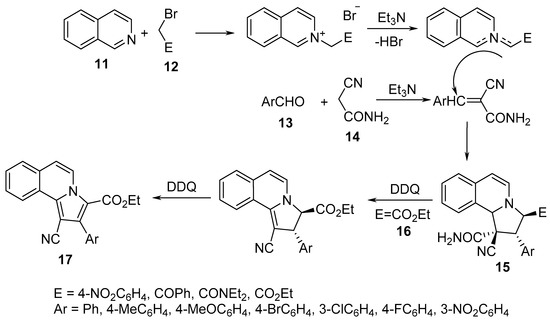
Scheme 4.
Synthesis of pyrrolo[2,1-a]isoquinolines 15/17.
Spiro[indoline-3,2′-pyrrolidines] 21 were prepared by the [3+2]-cycloaddition reaction of benzoimidazol-2-yl-3-phenylacrylonitriles 18 with azomethine ylides, which was generated in situ from the condensation of isatin 19 and sarcosine 20 in refluxing ethanol. Similarly, spiro[indoline-3,5′-pyrrolo[1,2-c]thiazoles] 23 were formed by using thioproline 22 as a secondary amino acid (Scheme 5) [24].
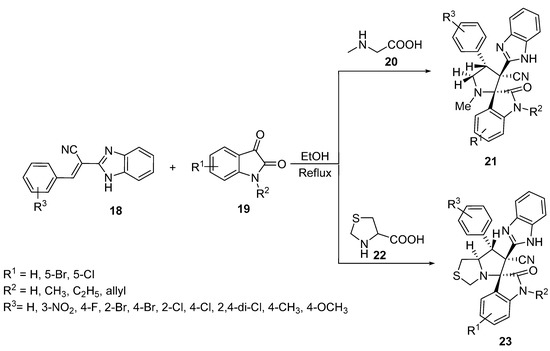
Scheme 5.
Synthesis of spiro[indoline-3,2′-pyrrolidines] 21 and spiro[indoline-3,5′-pyrrolo[1,2-c]thiazoles] 23.
The chemistry was extended further to obtain spiro[acenaphthylene-1,2′-pyrrolidines] 26 and spiro[acenaphthylene-1,2′-pyrrolizidines] 28 possessing a cyano group from the azomethine ylides (generated from acenaphthenequinone 25) with α-amino acids (sarcosine 20 and proline 27) and Knoevenagel adducts 24 (Scheme 6) [25].

Scheme 6.
Synthesis of spiro[acenaphthylene-1,2′-pyrrolidines] 26 and spiro[acenaphthylene-1,2′-pyrrolizidines] 28.
2.2. Nitroalkenes
Nitroalkenes are reactive, unsaturated 2π-electron components that are intensively used in cycloaddition reactions by various researchers [26]. 3-Nitro-4-(trichloromethyl)pyrrolidine 30 was obtained through the cycloaddition of trans-3,3,3-trichloro-1-nitroprop-1-ene 29 with azomethine ylide (obtained from the condensation of paraformaldehyde and sarcosine in refluxing benzene). Quantum chemical calculations (DFT, M062X/6-311G(d)) explained the reaction pathway [27]. Analogously, 3-nitro-4-arylpyrrolidine-3-carbonitriles 32 were obtained through the cycloaddition of the azomethine ylide with (2E)-3-phenyl-2-nitroprop-2-enenitriles 31 [28] (Scheme 7).
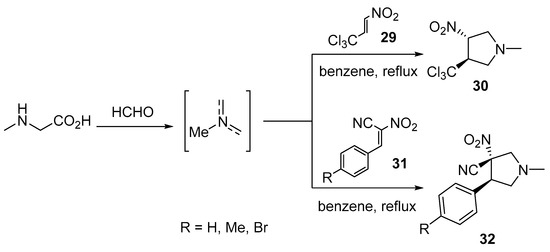
Scheme 7.
Synthesis of 3-nitro-4-(trichloromethyl)pyrrolidine 30 and 3-nitro-4-arylpyrrolidine-3-carbonitriles 32.
Trans-3-nitropyrrolidine 34 was prepared by reacting trans-1-nitro-2-phenylethylene 33 with N-(methoxymethyl)-N-[(trimethylsilyl)methyl]benzylamine 1, which is an azomethine ylide equivalent, in the presence of trifluoroacetic acid in dichloromethane. Some of the synthesized 34 revealed promising inhibitory properties as Na+ channel blockers, which are useful in the treatment of ischemic stroke (Scheme 8) [29].

Scheme 8.
Synthesis of trans-3-nitropyrrolidine 34.
Another set of spiro compounds, spiro[pyrrolidine-2,3′-oxindoles] 37, were regioselectively synthesized by a multicomponent reaction of azomethine ylides, generated in situ from 3-aminoindoline-2-ones hydrochloride 35, with aldehydes 13 and (E)-nitroalkenes 36 (Scheme 9) [30].

Scheme 9.
Synthesis of spiro[pyrrolidin-2,3′-oxindoles] 37.
It was assumed that, based on the secondary orbital interaction (SOI) of the electron-poor nitroalkenes 36 with the azomethine ylide, Path A was exclusively followed, as the endo-transition state in the reaction sequence was more energetically favorable (Scheme 10) [30].
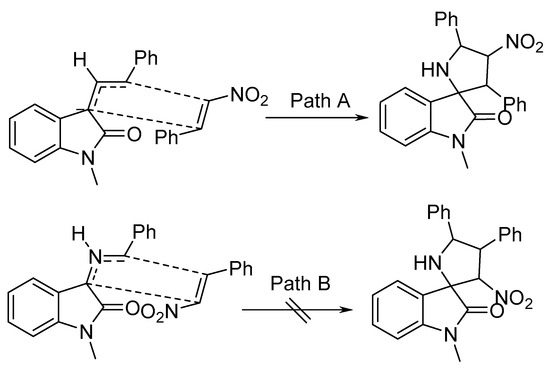
Scheme 10.
Proposed mechanism for the cycloaddition of azomethine ylide (via endo′-transition state).
Spirooxindolo-nitropyrrolizines 38 (major product) and 39 (minor product) were obtained from the cycloaddition reaction of azomethine ylides, generated in situ from isatin 19, with proline 27 and (E)-ß-nitrostyrene 32 (Scheme 11) [31]. A significant inversion in the regioselectivity was observed when the polar [3+2]-cycloaddition of the azomethine ylides was attempted with trans-β-nitrostyrene instead of (E)-1-phenyl-2-nitropropene.

Scheme 11.
Synthesis of spirooxindolo-nitropyrrolizines 38 and 39.
It was assumed that the reaction proceeds through S-shaped ylide with a cycloaddition via the endo-transition state (pathway B), yielding cycloadducts 38, and not the exo-transition state (pathway A). Computational studies (Gaussian 03) of the transition states (Density Functional Theory (DFT), B3LYP, and 6-31G(d,p) basis set) confirmed these assumptions (Scheme 12) [31].
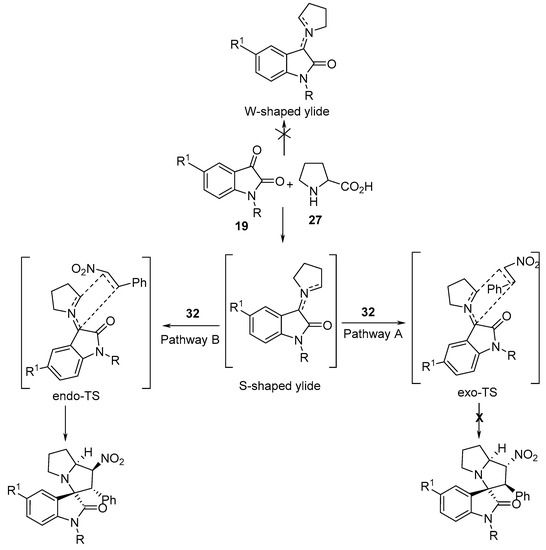
Scheme 12.
Proposed mechanism for the cycloaddition of the azomethine ylides with nitrostyrene.
A series of spiro[indoline-3,3′-pyrrolizin]-2-ones 40 with potential anti-amyloidogenic properties useful against Alzheimer’s disease were obtained by the microwave-assisted cycloaddition of nitroalkenes 36 and azomethine ylides (generated from isatin 19 and L-proline 27) [32]. Analogously, spirooxindole-pyrrolidines 42 were obtained by the reaction of tyrosine 41 in an ionic liquid [bmim]Br at 100 °C. Promising antiproliferation properties were observed for some of the synthesized compounds (42) against human A549 (adenocarcinoma basal epithelial) and Jurkat (T-cell lymphoma) cell lines (MTT assay) using Camptothecin as a positive control; the compounds exhibited a safe response against the non-cancer cell lines MCF-10 (normal breast) and PCS-130-010 (lung smooth muscle). Caspase-dependent apoptosis (especially caspase-3) was mentioned as the mode of action for the observed antiproliferative activity (Scheme 13) [33].

Scheme 13.
Synthesis of spiro-indolines 40, 42.
Ionic liquid chemistry was utilized to prepare 4′-nitrospiro[indeno[1,2-b]quinoxaline-11,2′-pyrrolidines] 47 by the cycloaddition reaction of nitroalkenes 36 with azomethine ylide (generated from indenoquinoxalinone 45 and L-phenylalanine 46) in an ionic liquid [bmim]Br. Some of the synthesized agents revealed antimycobacterial properties (Mycobacterium tuberculosis H37Rv) with an efficacy comparable to that of ethambutol (reference standard) [34]. Similarly, spiro compounds 49 were obtained by using L-histidine 48 instead of L-phenylalanine 46 in this reaction. Some of the synthesized compounds revealed cholinesterase (acetylcholinesterase and butyrylcholinesterase)-inhibitory properties with considerable efficiencies relative to Galantamine (Scheme 14) [35].
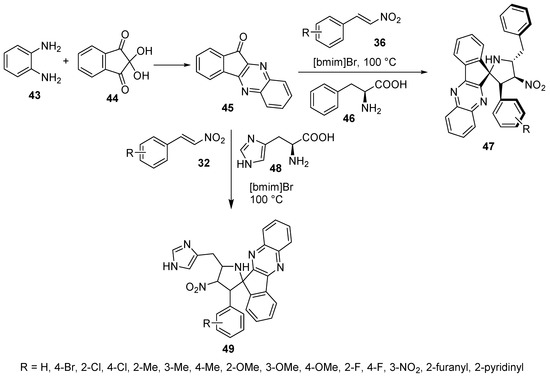
Scheme 14.
Synthesis of 4′-nitrospiro[indeno[1,2-b]quinoxaline-11,2′-pyrrolidines] 47, 49.
Pyrrolidinyl ß-lactams 52 were prepared as single diastereomers by the reaction of azomethine ylides 51, generated from β-lactam imines of α-amino ester 50, with nitrostyrenes 36 in the presence of silver acetate and triethylamine (Scheme 15). This reaction is an example of [3+2]-cycloaddition reaction via N-metallo azomethine ylide [36].
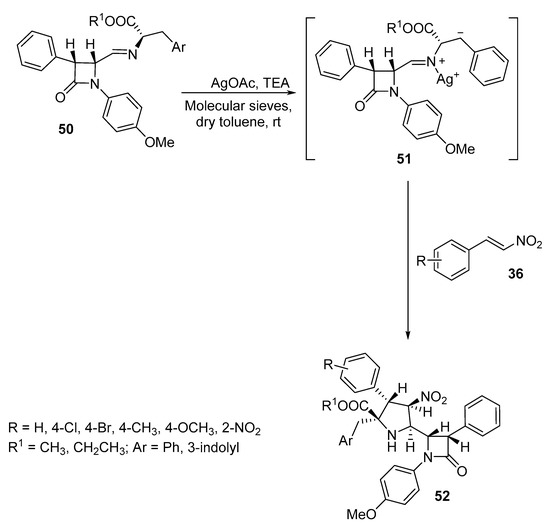
Scheme 15.
Synthesis of pyrrolidinyl β-lactams 52.
3,4-Dihydropyrrolo[2,1-a]isoquinolines 54 were obtained by the [3+2]-cycloaddition reaction of nitroalkenes 36 with an azomethine ylide that was efficiently generated via the dirhodium(II)caprolactamate [Rh2(cap)4] catalyzed oxidation of tetrahydroisoquinoline 53 (Scheme 16). Doyle’s oxidative protocol was used to generate azomethine ylides, which were further trapped in situ via [3+2]-cycloaddition [37].
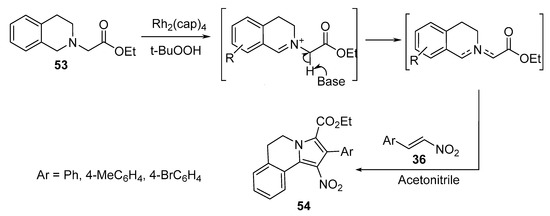
Scheme 16.
Synthesis of pyrrolo[2,1-a]isoquinolines 54.
2.3. α,β-Unsaturated Polarophiles
Spiro[3H-indole-3,3′-[3H]pyrrolizin]-2-ones 56 were synthesized by the cycloaddition reaction of (E)-3-aryl-1-(thiophen-2-yl)-prop-2-en-1-ones 55 with azomethine ylide generated in situ from the condensation of isatin 19 with L-proline 27 (Scheme 17). Some of the synthesized spiroindoles 56 showed potential antibacterial activity against Staphylococcus aureus and Salmonella typhi (relative to Streptomycin) and antifungal activity against Candida albicans (relative to Amphotericin B) [38].

Scheme 17.
Synthesis of spiro[3H-indole-3,3′-[3H]pyrrolizin]-2-ones 56.
Spiro[pyrrolidine-2,3′-indolin]-2′-ones 59 were synthesized by the multi-component cycloaddition reaction of chalcones 58 and an azomethine ylide formed from the condensation of isatin 19 and benzylaminemine 57. Few of the synthesized spiro-analogs 59 revealed potent inhibitory advanced glycation end (AGE) product formation in a bovine serum albumin (BSA)-glucose assay that was higher than that of aminoguanidine (standard reference). The occurrence of AGE is related to hyperglycemia observed as a complication of diabetes (Scheme 18) [39].

Scheme 18.
Synthesis of spiro[pyrrolidine-2,3′-indolin]-2′-ones 59.
Taghizadeh et al. reported an efficient and greener multicomponent protocol for the synthesis of regio-, diastereo-, and enantioselective spiro-oxindolopyrrolizidines 61 from optically active cinnamoyl oxazolidinone 60 and azomethine ylides that were formed from the condensation reaction of isatin 19 and S-proline 27 (Scheme 19) [40].

Scheme 19.
Synthesis of the spiro-oxindolopyrrolizidines 61.
Spiro[indoline-3,2′-pyrrolidines] 63 were prepared by the reaction of compound 62 containing an α,β-unsaturated ketone function with azomethine ylides obtained from isatin 19 and sarcosine 20, while spiro[indoline-3,5′-pyrrolo[1,2-c]thiazoles] 64 was obtained from a similar reaction that involved thioproline 22 instead of sarcosine 20 (Scheme 20). Some of the synthesized spiro-compounds, 63 and 64, revealed anticancer properties against the A549 lung cancer cell line (MTT assay) [41,42] and spiro-compound 63 also showed antimicrobial activity against Gram-positive (Micrococcus luteus, Enterobacter aerogenes, Staphylococcus aureus and Staphylococcus aureus “MRSA-methicillin resistant”) and Gram-negative (Salmonella typhimurium, Klebsiella pneumoniae, Proteus vulgaris, and Shigella flexneri) bacterial strains and fungi (Malassesia pachydermatis, Candida albicans) relative to Streptomycin and Ketoconazole (used as antibacterial and antifungal standard references, respectively) [42].
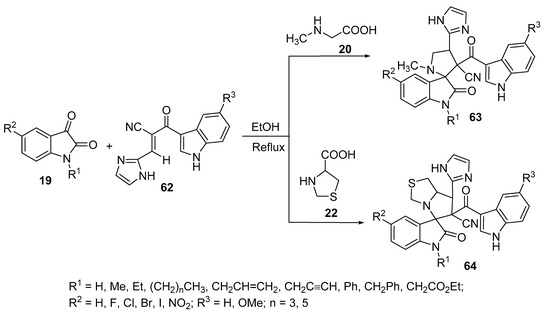
Scheme 20.
Synthesis of spiro[indoline-3,2′-pyrrolidines] 63 and spiro[indoline-3,5′-pyrrolo[1,2-c]thiazoles] 64.
Spiropyrrolidine-oxindoles 66 were prepared in appreciable yields by the cycloaddition reaction of the unsaturated 2π-electron component (E)-2-(1H-indole-3-carbonyl)-3-phenylacrylonitrile 65 and azomethine ylides obtained from the condensation of isatin 19 and sarcosine 20 (Scheme 21) [43].
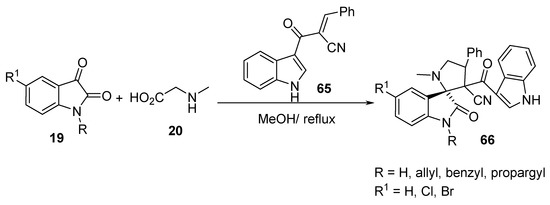
Scheme 21.
Synthesis of spiropyrrolidine-oxindoles 66.
Similarly, spiropyrrolidine–oxindoles 68–70 were obtained from the reaction of enone 67 with azomethine ylides derived from isatin 19 and α-amino acids (sarcosine 20, proline 27 or thioproline 22). Among all the synthesized compounds, some showed antimicrobial properties against Gram-positive and Gram-negative bacterial as well as fungal strains using Streptomycin and Ketconazole as standard references (Scheme 22) [44].
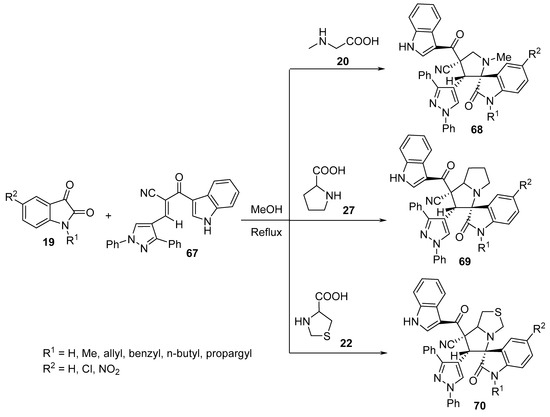
Scheme 22.
Synthesis of spiropyrrolidine-oxindoles 68–70.
The unsaturated 2π-electron component, 2-[hydroxyl(4-oxo-4H-chromen-3-yl)methyl]acrylonitrile 71, was synthesized by the Baylis–Hillman reaction of chromene-3-aldehyde, treated with the azomethine ylides (from isatin 19 and sarcosine 20), which afforded the corresponding regioselective spiro[pyrrolidine-oxindoles] 72 and 73 as major and minor products, respectively (Scheme 23) [45].

Scheme 23.
Synthesis of spiro[pyrrolidine-oxindoles] 73, 74.
A convenient method for the selective construction of spiroindane-1,3-diones 77 relies upon the generation of unstabilized azomethine ylides from the initial condensation between ninhydrin 44 and 1,2,3,4-tetrahydroisoquinoline 74. Subsequent azomethine ylide cycloaddition onto the conjugated double bond of chalcone 76 was exploited, giving target cycloadducts with good yields (77–94%) and diastereoselectivity (Scheme 24) [46].
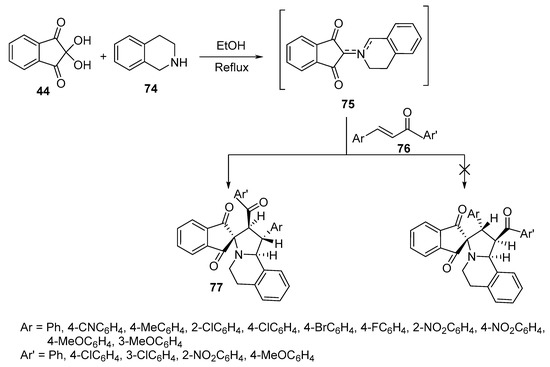
Scheme 24.
Synthesis of spiroindane-1,3-diones 77.
The reaction of azomethine ylide generated from 5-choloroisatin 19 and L-proline 27 as well as 1-acryloyl-4-piperidinones 78 yielded the corresponding spirooxindole-pyrrolizines 79 (yield 62–84%). Some of the synthesized cycloadducts 79 displayed cholinesterase-inhibitory properties (acetylcholinesterase and butyrylcholinestrase) with potency relative to Galantamine [47]. When the reaction was conducted in a 1:2:2 molar ratio of 1-acryloyl-4-piperidinones 78, isatin 19, and L-proline 27, respectively, the bisspiropyrrolizines 80 were formed instead (yield 53–74%). It was found that most of the mono-spiropyrrolizines 79 (obtained using a 1:1:1 molar ratio of the reactants in yields of 73–84%) revealed higher cholinesterase enzyme (acetylcholinesterase and butyrylcholinestrase)-inhibitory activity than the bisspiropyrrolizine derivatives 80 (Scheme 25) [48].
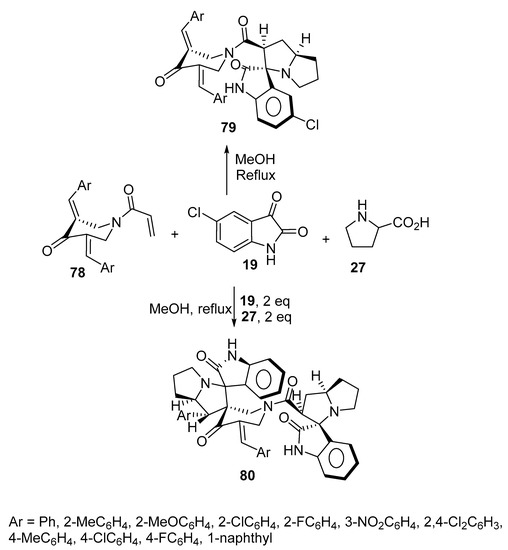
Scheme 25.
Synthesis of mono-spiropyrrolizines 79 and bisspiropyrrolizines 80.
The reaction of 3-(3-phenylazetidin-2-yl) acrylates 81 with azomethine ylide formed by the condensation of ninhydrin 44 and amino acids (sarcosine 20/L-proline 27) afforded the corresponding spiroindanopyrrolidines 82 and spiroindanopyrrolizines 83 (Scheme 26). The synthesized cycloadducts 82 and 83 showed antibacterial properties against Proteus mirabilis, Proteus vulgaris, Salmonella typhi, and Staphylococcusi aureus relative to Tetracycline (standard reference drug) [49].
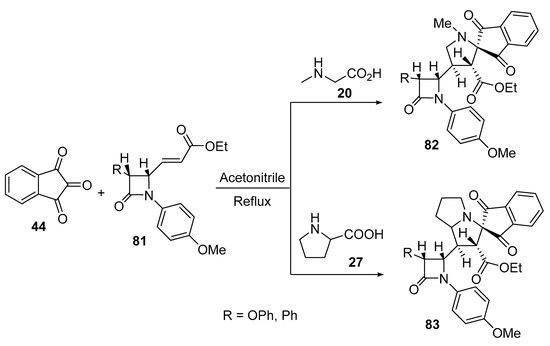
Scheme 26.
Synthesis of spiroindanopyrrolidines 82 and spiroindanopyrrolizines 83.
Cycloaddition of cinnamaldehydes 84 with azomethine ylides, generated from another cinnamaldehyde molecule 84 and L-proline 27, afforded hexahydro-1H-pyrrolizines 85 and 86 in different ratios depending on the heating method (conventional heating, 25–80 °C vs. with microwave technique) and the solvent used (MeCN, DMF, toluene, CH2Cl2, DMSO) (Scheme 27) [50].
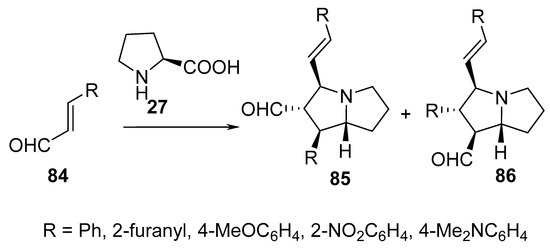
Scheme 27.
Synthesis of hexahydro-1H-pyrrolizines 85 and 86.
Pyrrolizidines of type 88 were obtained by reacting β,γ-unsaturated α-keto esters of type 87 with proline 27 in a 2:1 molar ratio. The reaction was assumed to proceed via the formation of azomethine ylides by the condensation of the starting unsaturated esters of type 87 with amino acid 27, which, in turn, interacted with another molecule of 87 to ultimately yield pyrrolizidines of type 88 (Scheme 28) [51].
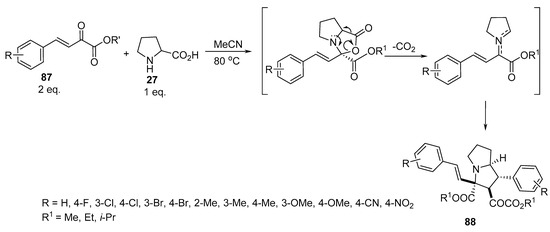
Scheme 28.
Synthesis of pyrrolizidines 88.
2.4. Acrylates
The reaction of O-acryloylacridinediones 89 with azomethine ylides, generated from isatin 19 and secondary amino acids (sarcosine 20/proline 27), afforded the corresponding spiro-pyrrolidines 90 and spiro-pyrrolizidines 91 (Scheme 29) [52].
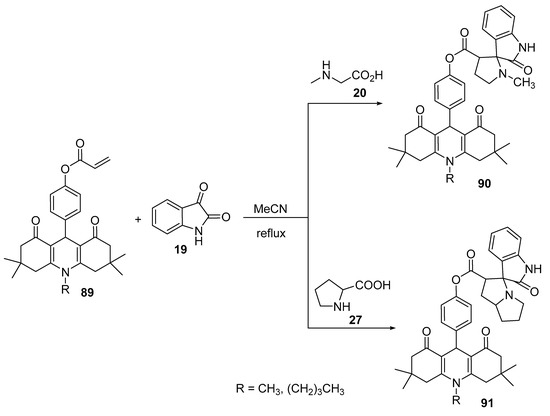
Scheme 29.
Synthesis of spiro-pyrrolidines/pyrrolizidines 90/91.
Spiropyrrolidines 94–97 were obtained via the reaction of methyl 2-(1H-inden-2-yl)acrylate 92 with azomethine ylides generated in situ by reacting ketones (isatin 19, acenaphthenequinone 25, ninhydrin 44, or 11H-indeno[1,2-b]quinoxaline-11-one 93) with sarcosine 20 (Scheme 30) [53].
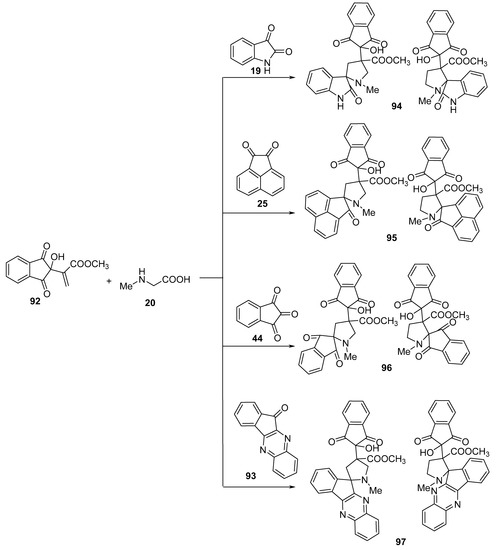
Scheme 30.
Synthesis of spiropyrrolidines 94–97.
The reaction of methyl lactate acrylates of type 98 with azomethine ylides, generated from imino-esters 5 in the presence of silver acetate and KOH, gave chiral proline derivatives of type 99 (Scheme 31) [54].

Scheme 31.
Synthesis of chiral prolines 99.
The reaction of trans arylacrylates 100 with the azomethine ylide, formed from benzyl-(methoxymethyl)[(trimethylsilyl)methyl]amine 1 in the presence of a catalytic amount of trifluoroacetic acid, afforded the corresponding trans pyrrolidine derivatives 101 (Scheme 32) [55].

Scheme 32.
Synthesis of trans pyrrolidines 101.
2.5. Intramolecular Cycloaddition Reaction of Azomethine Ylides with Acyclic Unsaturated 2π-Electron Components
2.5.1. Acyclicunsaturated 2π-Electron Components Containing Olefinic and Aldehyde Groups
Azomethine ylides (formed via the reaction of α-amino esters 103 with O-allyl-5-phenyldiazenylsalicylaldehyde 102) underwent intramolecular [3+2]-cycloaddition under microwave conditions, affording the 8-phenyldiazenylchromeno[4,3-b]pyrrolidines 104 (Scheme 33). The synthesized compounds showed antibacterial activity against Gram-positive (Streptococcus pneumoniae, Clostridium tetani, and Bacillus subtilis) and Gram-negative bacteria (Salmonella typhi, Vibrio cholerae, and Escherichia coli), fungi (Aspergillus fumigatus and Candida albicans), and mycobacteria (M. Tuberculosis H37RV) relative to the antibacterial (Ampicillin, Norfloxacin, Chloramphenicol, Ciprofloxacin), antifungal (Griseofulvin, Nystatin), and antimycobacterial (Metronidazole) standard references used [56].
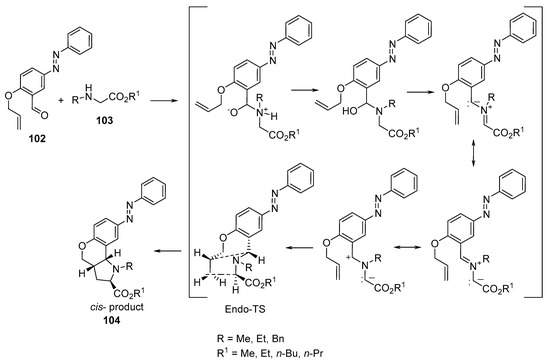
Scheme 33.
Synthesis of 8-phenyldiazenylchromeno[4,3-b]pyrrolidines 104.
The intramolecular cycloaddition reaction of azomethine ylides, formed from alkenyl aldehyde 105 and secondary amino acids (sarcosine 20, L-proline 27, thioproline 22, and tetrahydroisoquinoline-3-carboxylic acid 106), afforded the corresponding chromenopyrrole derivatives 107–109 (Scheme 34). The synthesized compounds showed promising antibacterial (against S. aureus, B. subtilis “Gram-positive”; S. pneumoniae, E. coli, and Shigella sp., S. typhi “Gram-negative”) and antifungal (against Trichoderma sp., Aspergillus sp. and C. albicans) activities against the references Tetracycline and Carbendazim (antibacterial and antifungal standard references, respectively) [57].
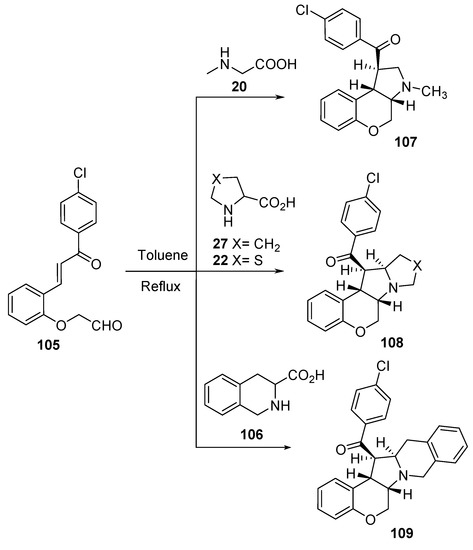
Scheme 34.
Synthesis of chromenopyrrole-containing compounds 107–109.
The intramolecular cycloaddition of O-allyl salicylaldehydes 110 and sarcosine 20 under ultrasonic irradiation in methanol at room temperature yielded the corresponding chromeno[4,3-b]pyrroles 111 (Scheme 35) [58].

Scheme 35.
Synthesis of chromeno[4,3-b]pyrroles 111.
Chromeno[4,3-b]pyrrolidines 113 were obtained in a highly regio- and stereoselective manner by the intramolecular cycloaddition of O-allylic salicylaldehydes 112 and sarcosine 20 (Scheme 36) [59].

Scheme 36.
Synthesis of chromeno[4,3-b]pyrrolidines 113.
Similarly, hexahydrochromeno[4,3-b]pyrroles 116 were obtained via intramolecular [3+2}-cycloaddition of O-allylic salicylaldehyde 114 and amines 115 under microwave conditions (Scheme 37) [60].
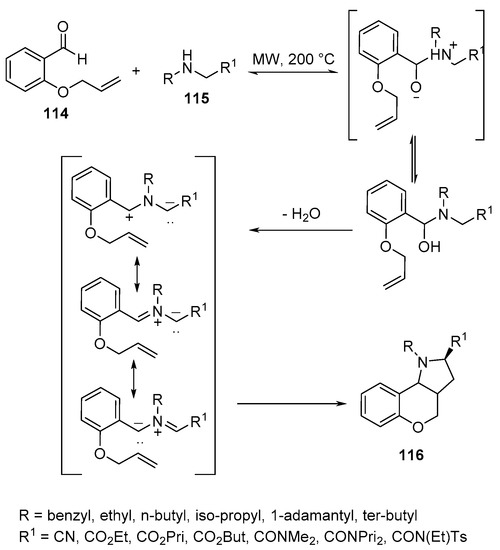
Scheme 37.
Synthesis of hexahydrochromeno[4,3-b]pyrroles 116.
Bicyclic pyrrolo[3,4-b]pyrroles 118 were obtained by the intramolecular cyclization of the generated azomethine ylides from aldehydes 117 and sarcosine 20 under refluxing conditions in toluene (Scheme 38) [61].
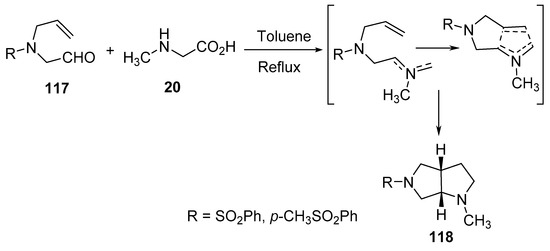
Scheme 38.
Synthesis of pyrrolo[3,4-b]pyrroles 118.
Octahydropyrrolo[3,4-b]pyrroles 121 with various substituents in their aromatic rings were synthesized by the intramolecular cycloaddition of azomethine ylides, which was formed from the reaction of alkenyl aldehyde 119 with N-aryl glycines 120 (Scheme 39) [62].

Scheme 39.
Synthesis of octahydropyrrolo[3,4-b]pyrroles 121.
The condensation of N-alkenyl aldehydes 122 with α-amino acids (sarcosine 20, thioproline 22 and proline 27) generated azomethine ylides, which underwent an intramolecular cycloaddition reaction yielding the corresponding polycyclic compounds 123 and 124 (Scheme 40) [63].
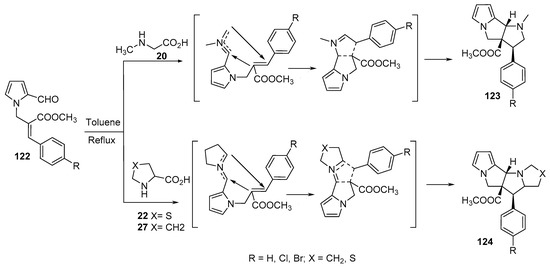
Scheme 40.
Synthesis of polycyclic compounds 123 and 124.
Similarly, the intramolecular reaction of azomethine ylide obtained from 2-butenylindole-3-carboxaldehyde 125 with N-methyl glycine ethyl ester hydrochloride 126 gave the indole-containing alkaloid 127. Whereas its reaction with N-methyl glycine 20 or N-allyl glycine 128 gave the corresponding indole heterocycles of type 129 (Scheme 41) [64].
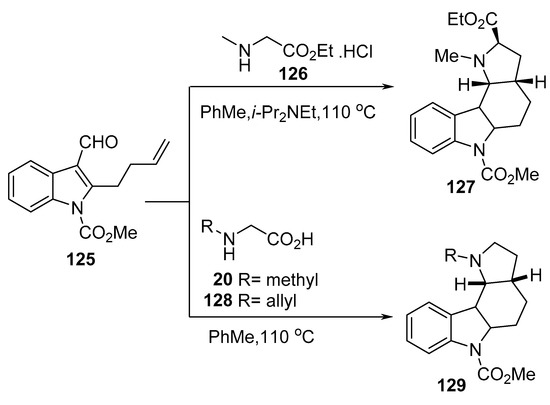
Scheme 41.
Synthesis of indole-containing heterocycles 127 and 129.
Another example of intramolecular cycloaddition was the reaction of (E)-2-{[allyl(benzyl)amino]methyl}cinnamaldehydes 130 with proline methyl ester hydrochloride 131 under microwave conditions, which afforded the pyrido[3,4-b]pyrrolizines 132 (Scheme 42) [65].
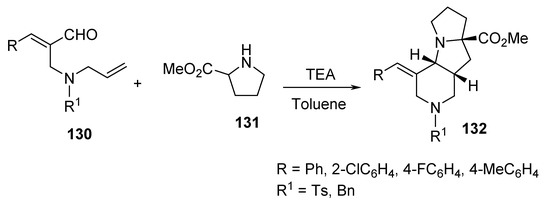
Scheme 42.
Synthesis of pyrido[3,4-b]pyrrolizines 132.
By using 1,2-O-cyclohexylidine-3-O-allyl-α-D-xylopentadialdo-1,4-furanose 133 (sugar-derived aldehyde) in a reaction with sarcosine 20, furopyranopyrrolidine of type 134 was formed with high diastereoselectivity (Scheme 43) [66].

Scheme 43.
Synthesis of furopyranopyrrolidine 134.
The intramolecular [3+2]-cycloaddition of azomethine ylides, generated from 2-formylphenyl-(E)-2-phenylethenesulfonates 135 and sarcosine 20, afforded the corresponding [1,2]oxathiino[4,3-b]pyrroles 136. However, the reaction of derivative 135 with L-proline 27 gave the corresponding [1,2]oxathiino[3,4-b]pyrrolizines 137 as trans–trans (major) and cis–trans (minor) isomers (Scheme 44) [67].
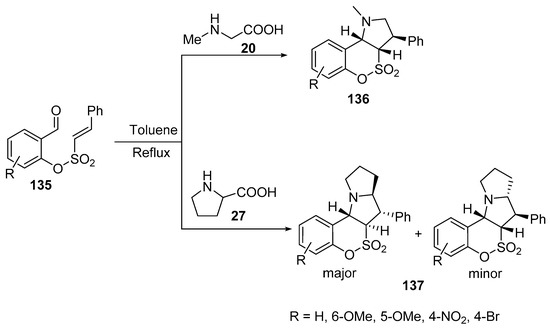
Scheme 44.
Synthesis of benzo[e][1,2]oxathiino[4,3-b]pyrrole-4,4-dioxides 136 and benzo[e][1,2]oxathiino[3,4-b]pyrrolizine-6,6-dioxides 137.
Scheme 45 shows an interesting example of a macrocycle of type 139 formation via the intramolecular cycloaddition of an azomethine ylide generated from a triazole-linked glycol-nitroalkenyl aldehyde derivative 138 and sarcosine 20 [68].

Scheme 45.
Synthesis of macrocycle 139.
Polycyclic naphtho[2,1-b]pyrano-pyrrolizidine and indolizidine derivatives 141 and 143 were synthesized by the intramolecular [3+2]-cycloaddition of azomethine ylides generated from naphtho-O-alkenyl aldehydes 140 and α-amino acids (L-proline 27 or DL-pipecolinic acid 142) (Scheme 46) [69].
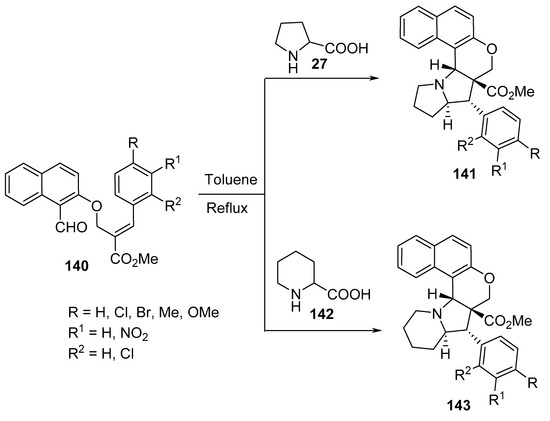
Scheme 46.
Synthesis of naptho-pyrano-pyrrolizidines/indolizidines 141 and 143.
2.5.2. Acyclic Unsaturated 2π-Electron Components Containing Olefinic Linkage and Azirdine
Scheme 47 shows the thermolysis of aziridines 144 that led to the in situ formation of azomethine ylides, which underwent intramolecular cycloaddition, thus affording N-phthalimidopyrrolidine derivatives 145 as a mixture of two diastereoisomers [70].

Scheme 47.
Synthesis of N-phthalimidopyrrolidines 145.
Another bicyclic system of γ-lactone 147 was created by the intramolecular [3+2]-cycloaddition of azomethine ylide generated via the thermolysis of aziridine derivative 146 in refluxing toluene (Scheme 48) [71].

Scheme 48.
Synthesis of bicyclic γ-lactone 147.
3. Exocyclic, Unsaturated 2π-Electron Components
3.1. Cycloalkanones
The exocyclic olefinic linkage is a reactive, unsaturated 2π-electron component intensively used in [3+2]-cycloaddition reactions forming various heterocycles [72,73,74,75,76]. For example, the cycloaddition of azomethine ylide (formed from isatin 19 and sarcosine 20) with 2-arylidene-1-cyclopentanones 148 in the presence of bentonite clay under microwave conditions afforded dispiropyrrolidinyl-oxindoles 149 (Scheme 49) [77].

Scheme 49.
Synthesis of dispiropyrrolidinyl-oxindoles 149.
Similarly, dispiro[cyclohexane-1,3′-pyrrolidine-2′,3″-[3H]indoles] 151 and 152 were obtained by the cycloaddition reaction of azomethine ylides (generated from isatin derivative 19 and sarcosine 20) with 2E,6E-bis(arylidene)-1-cyclohexanones 150 (Scheme 50). Some of the synthesized compounds demonstrated antitumor properties against liver (HEPG2), cervical (HELA), and prostate (PC3) cancer cell lines while using Doxorubicin as a standard reference in an SRB assay [78].

Scheme 50.
Synthesis of dispiro[cyclohexane-1,3′-pyrrolidine-2′,3″-[3H]indoles] 151 and 152.
Azomethine ylide formed from the condensation of benzylamine 57 and isatin 19 also underwent a cycloaddition reaction with 2,6-bis(ylidene)cyclohexanones 150 under solvent-free conditions using microwave irradiation, thereby affording the dispiro-oxindole 153 with high regioselectivity (Scheme 51) [79].

Scheme 51.
Synthesis of dispiro-oxindoles 153.
Azomethine ylides derived from acenaphthenequinone 25 and α-amino acids (sarcosine 20, phenylglycine 154, proline 27, or thioproline 22) afforded the corresponding spiro-cyclohexanones 155–158 upon reaction with 2,6-bis(ylidene)cyclohexanones 150 in refluxing methanol [80] (Scheme 52). Some of the synthesized spiro compounds revealed activity against Mycobacterium tuberculosis H37Rv (MTB) relative to Ethambutol and Pyrazinamide [80].
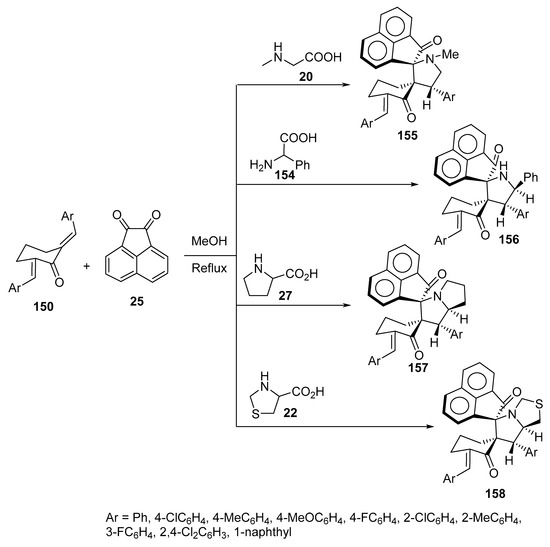
Scheme 52.
Synthesis of spirocyclohexanone 155–158.
A one-pot, five-component reaction of azomethine ylide (formed from ninhydrin 44, o-phenylenediammine 43, and sarcosine 20) with bis(ylidene)cycloalkanones 159 in the presence of hydrazine hydrate 160 in refluxing methanol regioselectively afforded the corresponding spiro-indenoquinoxaline-pyrrolidines 161 at a high yield (Scheme 53) [81].

Scheme 53.
Synthesis of spiro-indenoquinoxaline pyrrolidines 161.
Trispiropyrrolidines/thiapyrrolizidines 163 and 164 were synthesized through the reaction of 7,9-bis[(E)-ylidene]-1,4-dioxa-spiro[4,5]decane-8-ones 162 and azomethine ylides (formed from isatin 19 and sarcosine 20 or thioproline 22) in 2,2,2-trifluoroethanol (TFE) (Scheme 54). Some of the products showed anti-fungal properties (against Candida albicans MTCC 227, Aspergillus niger MTCC 282, and Aspergillus clavatus MTCC 1323) and antimycobacterial properties against M. tuberculosis H37Rv relative to the standard references Nysyatin, Greseofulvin (antifungal), and Isoniazid (antimycobacterial) [82].
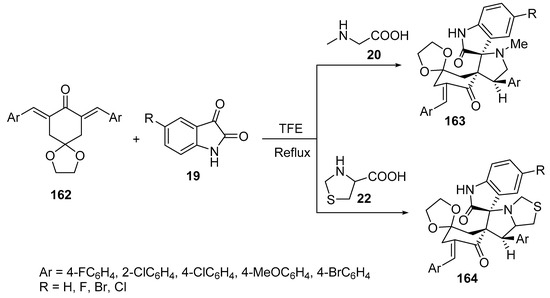
Scheme 54.
Synthesis of trispiropyrrolidines/thiapyrrolizidines 163, 164.
Analogously, dispiro compounds of type 165 were synthesized by the reaction of 2,6-bis(ylidene)cyclohexanones 150 with azomethine ylide (formed from L-thioproline 22 and isatin 19) in refluxing methanol. Some of the synthesized derivatives revealed promising antiproliferative properties (apoptotic mechanism) against the MCF7 (breast) and K562 (leukemia) cell lines (WST-1 assay) relative to 5-Fluorouracil (standard reference drug) (Scheme 55) [83].
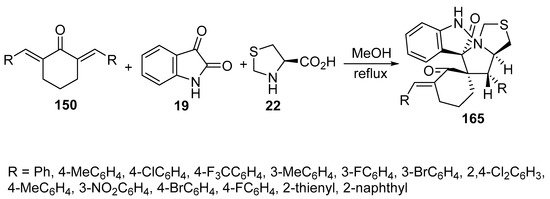
Scheme 55.
Synthetic route towards dispiro[cyclohexane-1,6′-pyrrolo[1,2-c].thiazole-5′,3″-indoline]-2,2″-diones 165.
3.2. Indanones and Indanediones
A series of dispiro compounds of type 167 were regioselectively synthesized by the cycloaddition of 2-(ylidene)-1-indanones 166 with azomethine ylides (formed from isatin derivatives 19 with sarcosine 20) in refluxing ethanol. Promising anti-inflammatory properties were exhibited by the synthesized compounds (via a rat carrageenan paw edema assay) relative to Indomethacin (standard reference drug) [84]. Antiproliferative properties were also revealed by some of the synthesized derivatives against human metastatic melanoma cells (GaLa, LuPiCi, and LuCa), with a potency relative to that of Doxorubicin (SRB assay) (Scheme 56) [85]. In an analogous reaction, by using L-thioproline 22 instead of sarcosine 20, spiro-pyrrolothiazolyloxindole derivatives of type 168 were obtained. Some of these compounds showed activities against Mycobacterium tuberculosis H37Rv relative to Ethambutol (standard reference) [86].
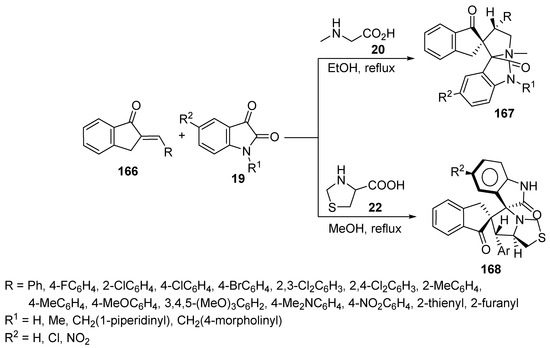
Scheme 56.
Synthetic route towards dispiro compounds 167 and 168.
Other dispiropyrrolidines of type 169 were synthesized by the cycloaddition of azomethine ylide (formed from ninhydrin 44 and sarcosine 20) with 2-(arylidene)-1-indanones 166 (Scheme 57). When acenaphthenequinone 25 was used instead of ninhydrin 44 in this reaction, dispiropyrrolidines of type 170 were formed in a highly regio- and stereoselective manner. Some of the synthesized derivatives—169 and 170 showed antimycobacterial properties against M. tuberculosis H37Rv and INH resistant M. tuberculosis strains relative to Isoniazid and Ethambutol (standard reference drugs) [87,88].
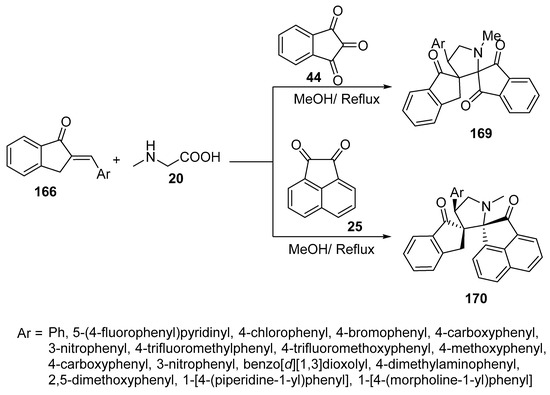
Scheme 57.
Synthesis of dispiropyrrolidines 166 and 167.
Dispiropyrrolidines 171 and 172 were obtained by the cycloaddition of 2-(ylidene)-1-indanones 166 with azomethine ylides (obtained through the condensation of L-thioproline 22 with ninhydrin/acenaphthenequinone 44/25) in refluxing methanol. Some of the synthesized compounds showed promising in-vitro antimycobacterial properties against M. tuberculosis H37RV relative to Cycloserine [89]. Analogously, pyrrolothiazolyloxindoles of type 173 were obtained when isatin 19 was used instead of ninhydrin 44 or acenaphthenequinone 25 in this reaction. Some of the isatin-derived compounds of type 173 exhibited inhibitory properties toward acetylcholinesterase that could be useful for Alzheimer’s disease therapy (Scheme 58) [90].
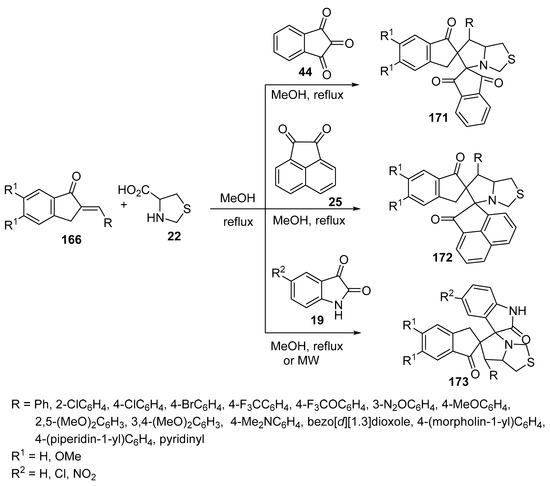
Scheme 58.
Synthetic route towards dispiro compounds 171–173.
By reacting 5,6-dimethoxy-2-(arylidene)-1-indanone 174 and isatin 19 with sarcosine 20 or phenylglycine 154, spiropyrrolidines 175 and 176, respectively, were obtained (Scheme 59). Some of these compounds showed inhibitory activities toward acetylcholinesterase [91].
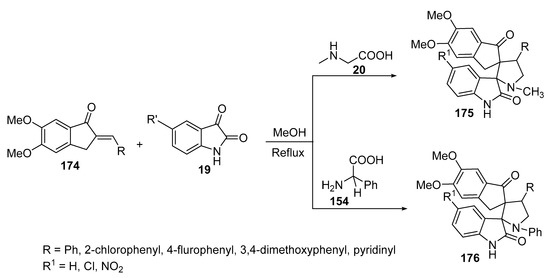
Scheme 59.
Synthesis of spiropyrrolidines 175 and 176.
TiO2–silica was used as an efficient solid-supported catalyst for the cycloaddition reaction of 2-arylidene-1,3-indanediones 177 with the corresponding azomethine ylides generated from tetrahydroisoquinoline-3-carboxylic acid 106 and isatin derivative 19 or acenaphthenequinone 25 to afford the corresponding dispiropyrroloisoquinolines 178 and 179 (Scheme 60) [92].
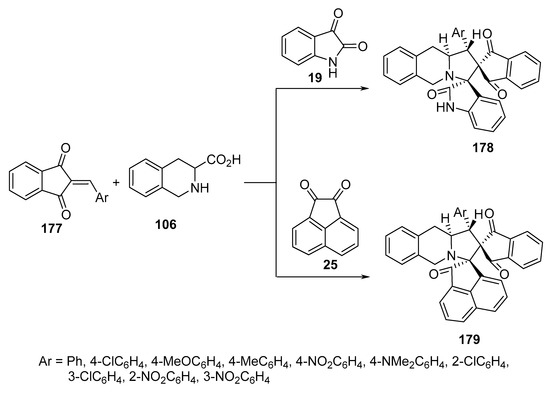
Scheme 60.
Synthesis of dispiropyrroloisoquinolines 178 and 179.
The four-component reaction of 2-arylidene-1,3-indanediones 177, ninhydrin 44, o-phenylenediamine 43, and L-proline 27, proceeding via an azomethine intermediate and in the presence of heteropolyacid H4[Si(W3O10)3]–silica as a catalyst in refluxing acetonitrile, afforded the dispiroindenoquinoxaline-pyrrolizidines 180 (Scheme 61) [93].
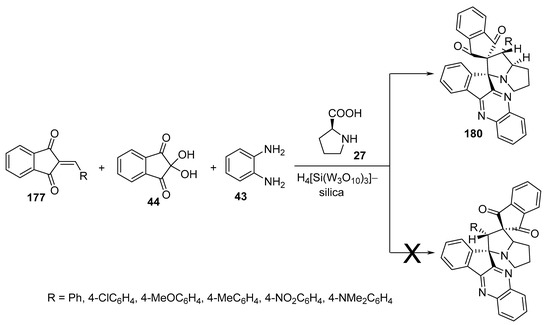
Scheme 61.
Synthesis of dispiroindenoquinoxaline-pyrrolizidine 180.
Dispiro compounds of type 182 were synthesized by the reaction of the generated azomethine ylides (from isatin 19 and sarcosine 20) with 2-(1,3-dioxo-indan-2-ylidene)malononitrile 181 (Scheme 62) [43].

Scheme 62.
Synthesis of spiroindane-1,3-diones 182.
3.3. Fluorenes
The solvent-free reaction of (E)-arylidenefluorenes 183 with isatin 19 and sarcosine 20 or proline 27, under microwave conditions, afforded the corresponding dispiro-oxindoles 184 and 185, respectively (Scheme 63) [94].
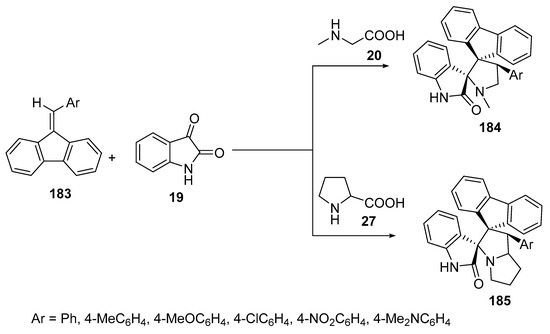
Scheme 63.
Synthesis of dispiro-oxindoles 184 and 185.
3.4. Acenaphthenes
The reaction of acenaphthenone-2-ylidene ketones of type 186 with azomethine ylides formed from the condensation of isatin 19 or acenaphthenequinone 25 and secondary amino acids (sarcosine 20 or L-proline 27) in refluxing methanol afforded the corresponding spirooxindoles 187–190 (Scheme 64) [95].

Scheme 64.
Synthesis of spirooxindoles 187–190.
Similarly, 2-oxo-(2H)-acenaphthylen-1-ylidene-malononitrile 191 afforded the corresponding dispiropyrrolidine-oxindoles 192 by its reaction with isatin 19 and sarcosine 20 in refluxing toluene (Scheme 65) [96].
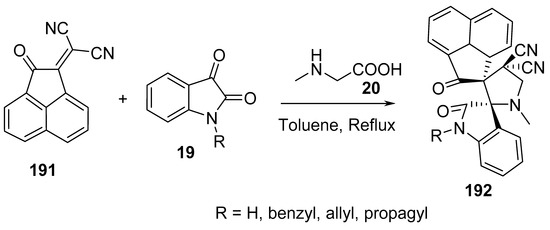
Scheme 65.
Synthesis of dispiropyrrolidine-oxindoles 192.
3.5. Tetralones
Dispiro-oxindolopyrrolidine/pyrrolizidines 194 and 195 were synthesized via the cycloaddition of (E)-1-naphthylidene-1-tetralone 193 with the corresponding azomethine ylides generated from isatin 19 and sarcosine 20 or L-proline 27 (Scheme 66) [97].
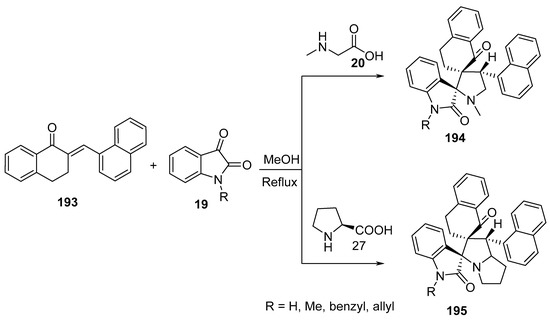
Scheme 66.
Synthesis of dispiro-oxindolopyrrolidine/pyrrolizidines 194 and 195.
Further, the cycloaddition of 1,4-bis(3′,4′-dihydro-1′-oxonaphthalen-2′-ylidene)benzene derivative 196 with azomethine ylides (from isatin 19 and sarcosine 20) in a 1:2 molar ratio afforded the corresponding tetraspiro-bisoxindolopyrrolidine 198. With a 1:1 ratio of the reactants, mono derivatives of type 197 were formed, which, in the presence of an excess of isatin 19 and sarcosine 20, afforded bisoxindolopyrrolidines 198 [98] (Scheme 67).
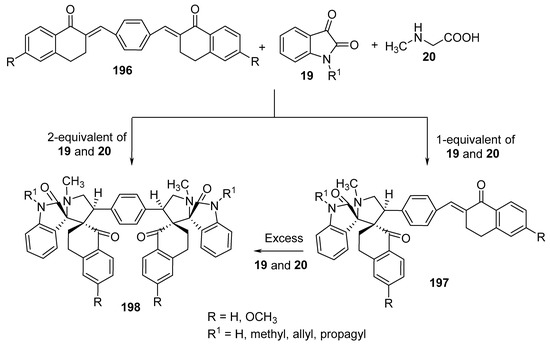
Scheme 67.
Synthesis of tetraspiro-bisoxindolopyrrolidines 198.
3.6. Pyrrolidine-2,5-diones
Dispiropyrrolidines of type 200 were prepared regioselectively by the cycloaddition of 3-(ylidene)pyrrolidine-2,5-diones 199 with azomethine ylide (formed from condensation of sarcosine 20 and isatin 19) in refluxing alcohol. Promising cholinesterase (acetylcholinesterase and butyrylcholinesterase) inhibitory properties were observed for some of the synthesized compounds (relative to Donepezil, used as the standard reference) that are of potential importance for fighting Alzheimer’s disease (Scheme 68) [99]. Some of the synthesized 200 also revealed antibacterial activities against Bacillus subtilis NCIM 2718, Staphylococcus aureus NCIM5021, Salmonella typhi NCIM2501, Pseudomonas aeruginosa NCIM 5029, and Proteus vulgaris NCIM2813 relative to Ampicillin [100].
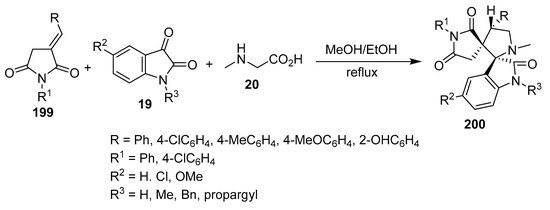
Scheme 68.
Synthetic route towards dispiro[indoline-3,2′-pyrrolidine-3′,3″-pyrrolidines] 200.
3.7. Lactones
Dispiropyrrolidino/pyrrolizidino-oxindoles 202 and 203 were obtained through the cycloaddition of α,ß-unsaturated-γ-lactone 201 with isatin 19/sarcosine 20 or isatin 19/proline 27 reagent systems (Scheme 69) [101].
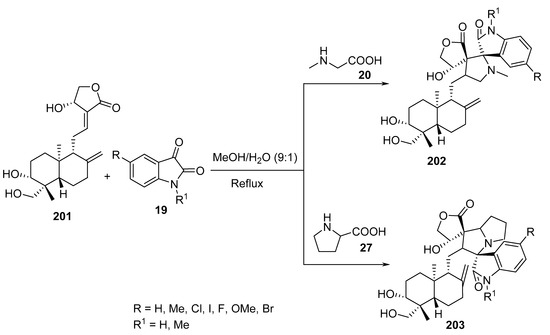
Scheme 69.
Synthesis of dispiropyrrolidino/pyrrolizidino-oxindoles 202 and 203.
Glycospiro-2,3-dihydropyrrolo[2,1-a]isoquinolines 206 were synthesized by the reaction of 3-deoxy-3-C-[(Z)-(methoxycarbonyl)methylene]-1,2:5,6-di-O-isopropylidene-α-D-glucofuranose 205 with isoquinoline-based azomethine ylide formed from isoquinolines 11 and alkyl bromoacetates or 2-bromoacetophenones 204 in the presence of Cu(OTf)2–Et3N as a catalyst (Scheme 70) [102].
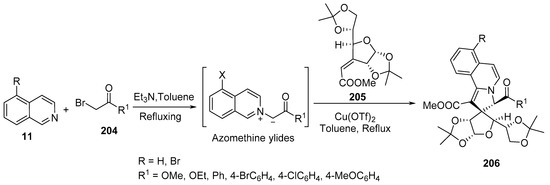
Scheme 70.
Synthesis of glycospiro-2,3-dihydropyrrolo[2,1-a]isoquinolines 206.
3.8. Thiophenones
The reaction of 2-(ylidene)thiophen-3-ones 207 with various azomethine ylides generated from sarcosine 20 and different ketones (isatin 19, ninhydrin 44 or acenaphthoquinone 25) afforded the corresponding dispiropyrrolidine containing-thiophenones 208–210 in good yields (Scheme 71) [103].
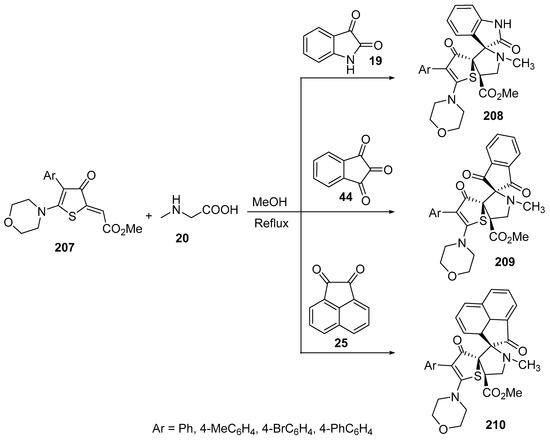
Scheme 71.
Synthesis of dispiropyrrolidine containing-thiophenones 208–210.
3.9. Oxazolones
The reaction of 4-ylidene-5-(4H)-oxazolones 211 with azomethine ylide derived from cis-4-formyl-2-azetidinone 212 and sarcosine 20 or pyrrolidine 27, in the presence of camphor sulphonic acid (CSA) as a catalyst, afforded the corresponding spiro[3.4′]-(oxazol-5′-one)-pyrrolidines 213 and spiro[3.4′]-(oxazol-5′-one)-pyrrolizidines 214, respectively (Scheme 72) [104].

Scheme 72.
Synthesis of spiro[3.4′]-(oxazol-5′-one)-pyrrolidines 213 and spiro[3.4′]-(oxazol-5′-one)-pyrrolizidines 214.
Spiro-compounds of types 216–219 were obtained via the cycloaddition reaction of 4-ylidene-5-oxazolones 211 and azomethine ylides (generated from isatin 19 and the appropriate α-amino acids). Some of the synthesized compounds showed considerable antitumor properties against breast cancer (MCF7, MDA-MB-231, and MDA-MB-468) and hepatocellular (HepG2, HCCC-9810, and HuH7) cell lines (MTT assay) relative to Gefitinib and Sorafenib (standard references) (Scheme 73) [105].
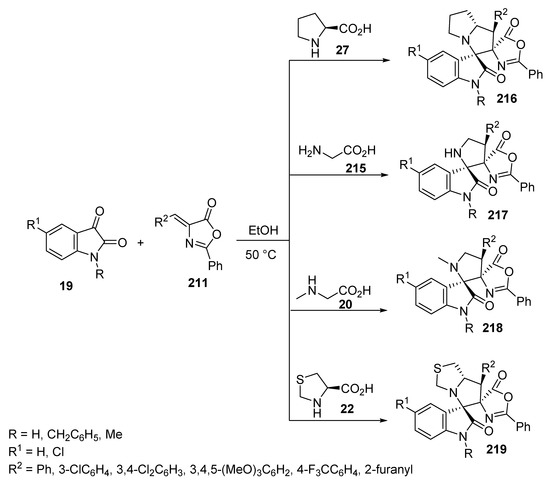
Scheme 73.
Synthetic route towards spiro-compounds 216–219.
3.10. Indoles
The azomethine ylide (formed from isatin 19 and sarcosine 20) underwent cycloaddition with 3-aroylmethyleneindol-2-ones 220 under green chemistry conditions in an ionic liquid ([bmim]PF6, 1-butyl-3-methylimidazolium hexafluorophosphate) to afford the corresponding dispiropyrrolidine-bisoxindoles 221 [106]. TiO2–silica was also used as a solid-supported catalyst under microwave conditions for the synthesis of dispiropyrroloisoquinolines 222 via the three-atom component cycloaddition reaction of azomethine ylide (generated from tetrahydroisoquinoline-3-carboxylic acid 106 and isatin 19) with 220 [92] (Scheme 74).

Scheme 74.
Synthesis of dispiropyrrolidines 221 and 222.
Dispiro-oxindolopyrrolizidines 223 and dispiro-oxindolothienopyrroles 224 could also be obtained by the reaction of azomethine ylides (generated from isatin 19 with L-proline 27 or R-thioproline 22) with 3-aroylmethyleneindol-2-ones 220 under ultrasonication conditions in the presence of silica as a catalyst (Scheme 75) [107].
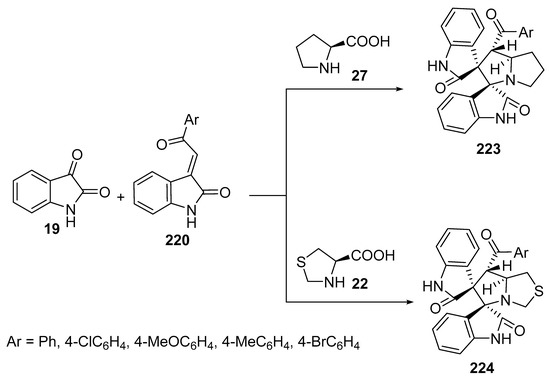
Scheme 75.
Synthesis of dispiro-oxindolopyrrolizidines 223 and dispiro-oxindolothienopyrroles 224.
Similarly, the cycloaddition reaction of 3-aroylmethyleneindol-2-ones 220 with azomethine ylide (formed from tetrahydroisoquinoline-3-carboxylic acid 106 and acenaphthenequinone 25) using TiO2–silica as a solid-supported catalyst under microwave conditions yielded dispiropyrroloisoquinoline 225 [92]. Ball-clay-supported zirconium oxychloride octahydrate was also used as a catalyst in the cycloaddition reaction of azomethine ylides (generated from acenaphthenequinone 25 and sarcosine 20 or L-proline 27) to produce spiro-oxindolopyrrolidine 226 and spiro-oxindolopyrrolizidine 227, respectively (Scheme 76) [108].
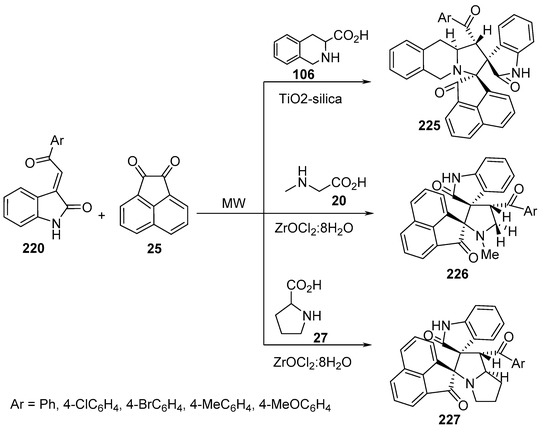
Scheme 76.
Synthesis of spiropyrrolidines 225–227.
Spiro-oxindoles of type 229 were obtained by reacting isatin 19, sarcosine 20, and 3-[2-oxo-ethylidene]indolin-2-one 228 in equimolar quantities whereas spiro-oxindole derivatives of type 230 were formed when isatin 19 and sarcosine 20 were used at a two-fold degree of molar excess over acceptor 228 (Scheme 77) [109].
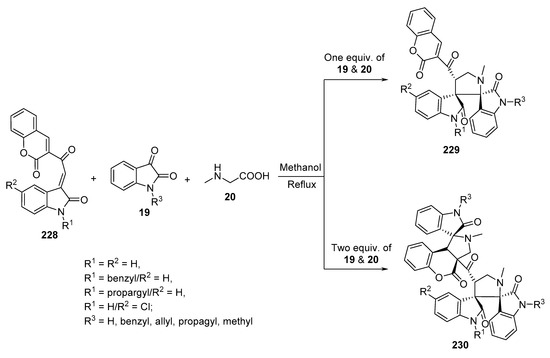
Scheme 77.
Synthesis of spiropyrrolidinyl-oxindoles 229 and 230.
Another dispirocyclopentanebisoxindole 232 can be obtained by the cycloaddition of azomethine ylides generated from 4-dimethylamino-1-alkoxycarbonylmethylpyridinium bromide 231 and aroylmethyleneindol-2-one 220 (Scheme 78) [110].
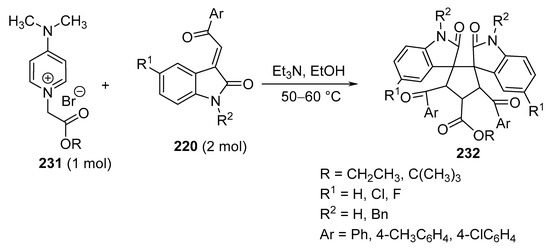
Scheme 78.
Synthesis of dispirocyclopentanebisoxindole 232.
The cycloaddition of aroylmethyleneindol-2-one 220 with azomethine ylide formed from indenoquinoxaline-11-one (generated in situ from ninhydrin 44 and o-phenylenediamine 43) and L-proline 27 was catalyzed by eteropolyacid H4[Si(W3O10)3]–silica and afforded the corresponding dispiroindenoquinoxaline-pyrrolizidine 233 (Scheme 79) [91].

Scheme 79.
Synthesis of dispiroindenoquinoxaline-pyrrolizidine 233.
The reaction of azomethine ylides—formed from the condensation of isatin 19 and sarcosine 20 or proline 27 in an ionic liquid [bmim] BF4 (without using any catalyst)—with 2-cyano-2-(2-oxoindolin-3-ylidene)acetate 234 yielded the corresponding dispiropyrrolidine-bisoxindole 235 and dispiropyrrolizidine-bisoxindole 236, respectively (Scheme 80) [111].
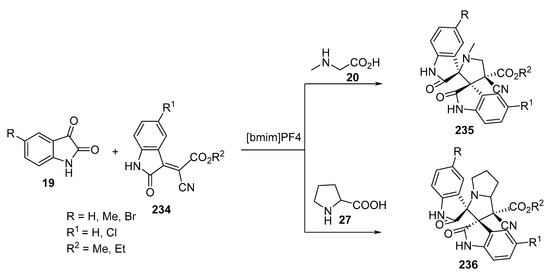
Scheme 80.
Synthesis of dispiropyrrolidine-bisoxindoles/dispiropyrrolizidine-bisoxindoles 235/236.
Spiropyrrolidine/spiropyrrolizine-oxindoles 238–241 were synthesized by a multi-component cycloaddition reaction of 2-oxo-(3H)-indol-3-ylidine-malononitrile 237 with azomethine ylides (generated from aromatic aldehyde 13 and sarcosine 20 or L-proline 27) in refluxing toluene containing molecular sieves (3 Å) (Scheme 81) [112].
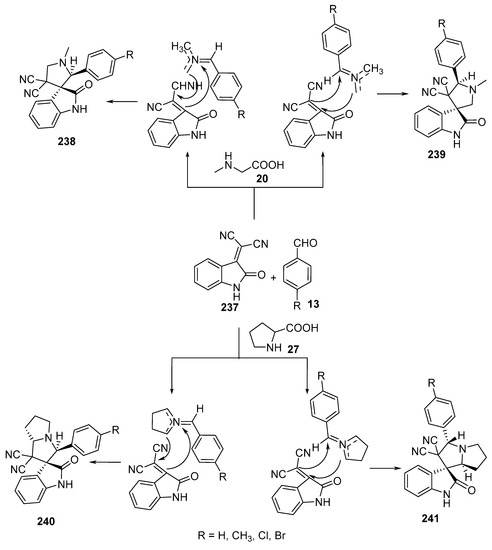
Scheme 81.
Synthesis of spiropyrrolidine/spiropyrrolizine-oxindoles 238–241.
In addition, dispiropyrrolidine-bisoxindole derivatives of type 242 were obtained from a three-atom component reaction of isatin 19, sarcosine 20, and isatylidene malononitrile 237 with high regioselectivity (Scheme 82) [43].
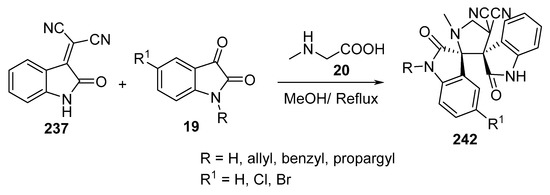
Scheme 82.
Synthesis of dispiropyrrolidine-bisoxindole 242.
Dispiro-oxindoles of type 243 were obtained by the dimerization of in situ generated azomethine ylides (A and B) via A+B pathways. X-Ray studies supported the postulated structures of type 243 (Scheme 83) [113].
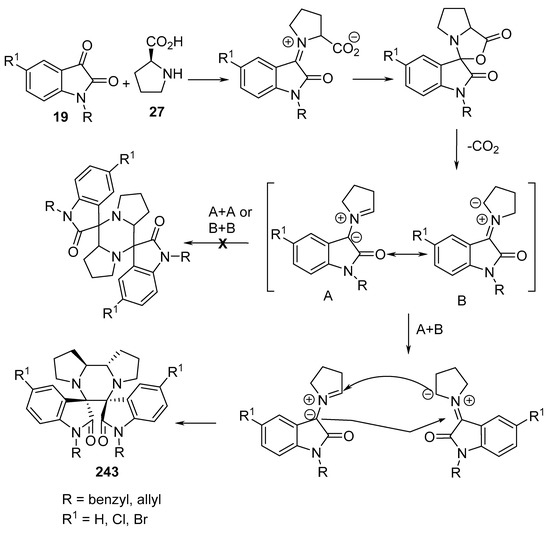
Scheme 83.
Synthesis of dispiro-oxindole 243.
3.11. Benzofuran-2-ones
Dispiro-oxindolopyrrolidine 245 and dispiro-oxindolopyrrolothiazole 246 were obtained by a multi-component reaction of 3-(ylidene)benzofuran-2-one 244 with isatin 19 and the appropriate α-amino acid (sarcosine 20 or thioproline 22, respectively) in refluxing methanol. Some of the synthesized compounds revealed promising antimycobacterial (M. tuberculosis H37Rv) properties relative to pyrazinamide (standard reference) (Scheme 84) [114].

Scheme 84.
Synthetic route towards dispiro-oxindolopyrrolidine 245 and dispiro-oxindolopyrrolothiazole 246.
3.12. Keto-Carbazoles
Dispiro[carbazole-2,3′-pyrrolo-2′,3″-indole] derivatives of type 248 were synthesized regio- and stereoselectively by the reaction of 2-ylidene-1H-carbazol-1-one 247 and in situ-generated azomethine ylide (formed from isatin 19 and benzylamine 57). Some of the obtained compounds revealed antiproliferative properties (MTT assay) via apoptosis induction against MCF7 (breast) and A-549 (lung) cancer cell lines relative to Cisplatin (Scheme 85) [115].

Scheme 85.
Synthesis of dispiro[carbazole-2,3′-pyrrolo-2′,3″-indoles] 248.
The reaction of (E)-2-arylidine-1-ketocarbazole 247 with various azomethine ylides generated from sarcosine 20 and di/tri ketone (isatin 19, ninhydrin 44, acenathenequinone 25) under microwave irradiation afforded the corresponding ketocarbazolodispiropyrrolidines 249–251 (Scheme 86). Some of the synthesized compounds showed antimicrobial properties against Proteus vulgaris, Proteus mirabilis, Staphylococcus aureus, and Salmonella typhi relative to Tetracycline [116].
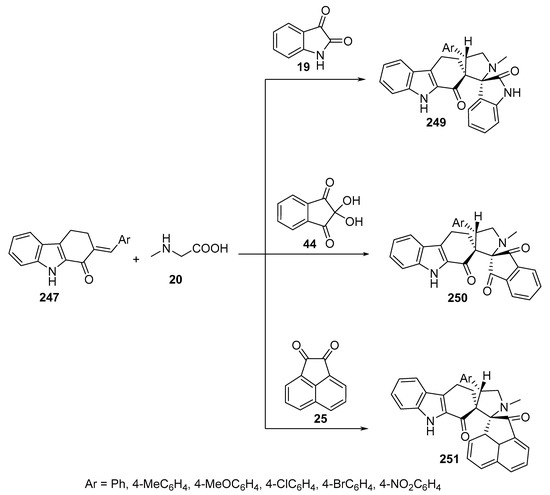
Scheme 86.
Synthesis of ketocarbazolodispiropyrrolidines 249–251.
Similarly, dispiro-oxindolopyrrolizidines of type 252 were prepared by reacting (E)-2-arylidine-1-ketocarbazole 247 with the azomethine ylide formed from isatin 19 and proline 27 (Scheme 87). Some of the products showed antimicrobial activities against human pathogens (Proteus vulgaris, Proteus mirabilis, Staphylococcus aureus, and Salamonella typhi) relative to Tetracycline and acted as inhibitors of plant fungal pathogen mycelial growth (Fusarium oxysporum and Macrophomena phaseolina) relative to the standard reference—Carbendazim [117].

Scheme 87.
Synthesis of dispiro-oxindolopyrrolizidines 252.
3.13. Piperidones
The reaction of isatin 19 with various amines (sarcosine 20, proline 27, and benzylamine 57) in refluxing methanol or in ionic liquid [bmim]Br generated the corresponding azomethine ylides that was added to 3-(arylidene)-4-piperidones 253 to form the corresponding spiropiperido-pyrrolizines/pyrrolidines 254–256 (Scheme 88). Some of the products showed activities against Mycobacterium tuberculosis H37Rv (MTB), multi-drug resistant M. tuberculosis (MDR-TB), and Mycobacterium smegmatis (MC2) relative to ethambutol and pyrazinamide (standard references) [118], and also had acetyl- and butyrylcholinesterase inhibitory properties (of potential use against Alzheimer’s disease) relative to galantamine [119].
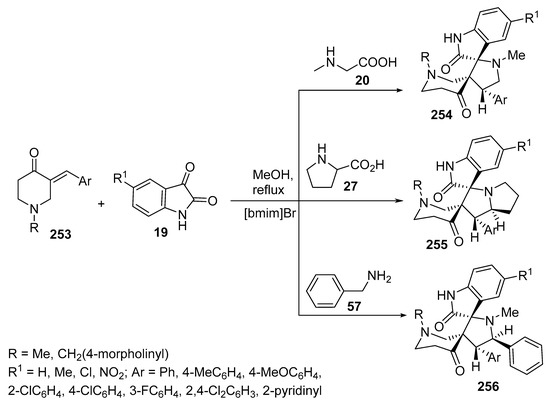
Scheme 88.
Synthesis of spiropiperido-pyrrolizines/pyrrolidines 254–256.
A variety of dispiro-heterocycles of types 260–263 were obtained via azomethine ylide intermediates (formed from isatin 19 and sarcosine 20, piperidine-2-carboxylic acid 258, thioproline 22, or 2-amino-3-phenylpropanoic acid 259) in a reaction with 3,5-bis(ylidene)-4-piperidone 257 (Scheme 89). Some of the synthesized analogs revealed considerable antiproliferation properties against a variety of tumor cell lines [120,121,122,123]. Promising anti-inflammatory properties were also exhibited by some of the synthesized compounds (50 mg/kg) in a rat model of carrageenan-induced paw edema (anti-edematous test) relative to indomethacin (10 mg/kg) [120,124]. Some derivatives of compound 262 showed activities against Mycobacterium tuberculosis H37Rv (MTB) and multi-drug resistant M. tuberculosis (MDR-TB) relative to ethambutol and pyrazinamide (standard references) [125], and had antifungal properties against Candida albicans ATCC 10231 with high inhibition of the fungal hyphae relative to fluconazole (standard reference drug) [126].
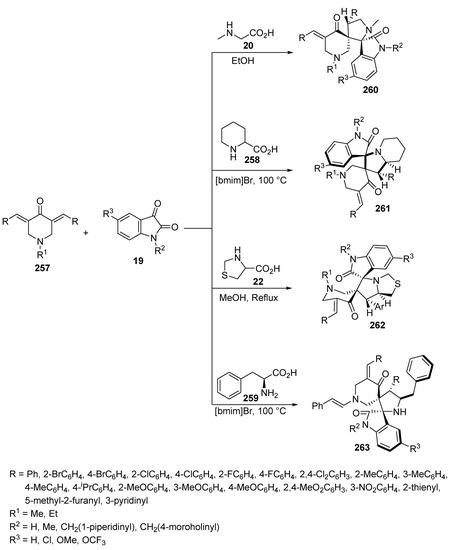
Scheme 89.
Synthesis of spiropyrrolidines 260–263.
Similarly, the reaction of 3,5-bis(ylidene)-4-piperidone 257 with a series of azomethine ylides generated from acenaphthenequinone 25 and α-amino acids (sarcosine 20, phenylglycine 154, proline 27, thioproline 22, or piperidine-2-carboxylic acid 258) afforded the corresponding spiropiperidone-containing compounds 264–268 (Scheme 90). Some of these derivatives revealed promising activities against Mycobacterium tuberculosis H37Rv (MTB), multi-drug resistant Mycobacterium tuberculosis (MDR-TB), and Mycobacterium smegmatis relative to Isoniazid [127]. Another group of the synthesized spiro-heterocycles 267 and 268 showed acetylcholine (AChE)-inhibitory properties relative to Donepezil HCl [128].
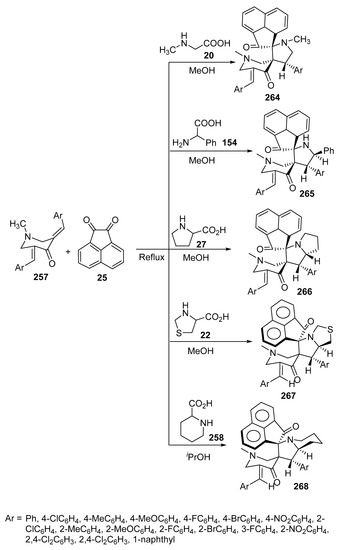
Scheme 90.
Synthesis of spiropiperidone-containing compounds 264–268.
A multicomponent reaction of 3,5-bis[(E)-ylidene]-4-piperidone 257, ninhydrin 44, o-phenylenediamine 43, and α-amino acid (sarcosine 20 or L-tryptophan 269) in 1-butyl-3-methylimidazoliumbromide ([BMIm]Br) used as an ionic liquid produced the corresponding dispiro compounds 270 and 271 [129,130] (Scheme 91). Significant acetylcholinesterase- (AChE) and butyrylcholinesterase (BChE)-inhibitory properties were shown by some of the synthesized compounds relative to galantamine (standard reference) [130].
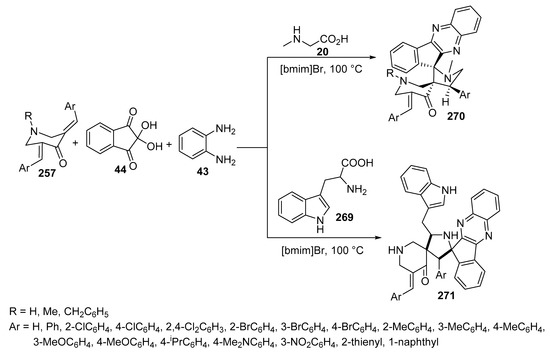
Scheme 91.
Synthesis of dispiro compounds 270 and 271.
Mono-spiropyrrolidines of type 272 were synthesized by the reaction of 1-acryloyl-3,5-bis(ylidene)-4-piperidinone 78 with azomethine ylide generated from isatin 19 and phenylglycine 154 from equimolar amounts of the reactants. Meanwhile, bisspiropyrrolidine derivatives of type 273 were formed using two equivalents, namely, isatin 19 and phenylglycine 154 (Scheme 92). Some of the synthesized compounds showed promising AChE- and BChE-inhibitory properties relative to Galanthamine [131].
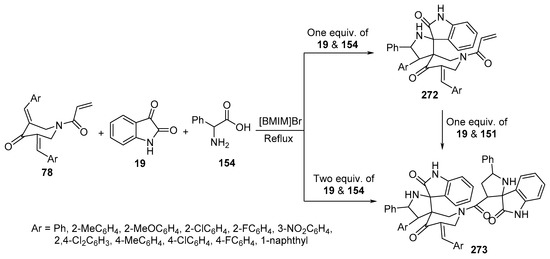
Scheme 92.
Synthesis of mono-spiropyrrolidines 272 and bisspiropyrrolidines 273.
Finally, the reaction of 3,5-bis(ylidene)-4-piperidone 257 with azomethine ylide formed from ninhydrin 44 and proline 27 in refluxing methanol afforded diazahexacycle 274 [132]. Similarly, 275–277 were obtained by the reaction of 257 with another azomethine ylides generated from ninhydrin 44 or acenaphthenequinone 25 with sarcosine 20 or L-phenylalanine 45 (Scheme 93) [133,134]. Some of the derivatives of type 274 exhibited inhibitory activities toward AChE relative to Donepezil HCl [132].

Scheme 93.
Synthesis of diazahexacycles 274–277.
3.14. Quinolones
Spiropyrrolidines 279 and 280 were synthesized by the reaction of (E)-3-(ylidene)-4-quinolone 278 with azomethine ylides formed from isatin 19 and sarcosine 20 or thioproline 22 (Scheme 94) [135].
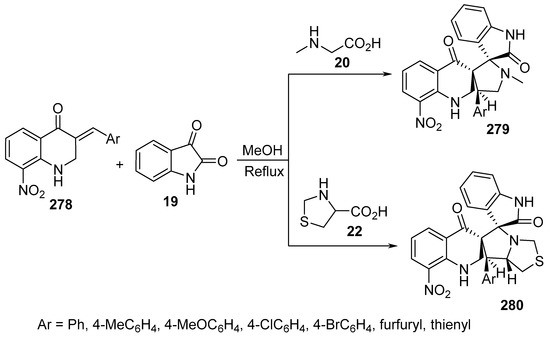
Scheme 94.
Synthesis of spiropyrrolidines 279 and 280.
3.15. Chromanones
The reaction of (E)-3-arylidene-4-chromanone of type 281 with azomethine ylides formed from acenaphthenequinone 25 and sarcosine 20 or proline 27 afforded spiropyrrolidines 282 and 283, respectively, with high regioselectivity (Scheme 95) [136].
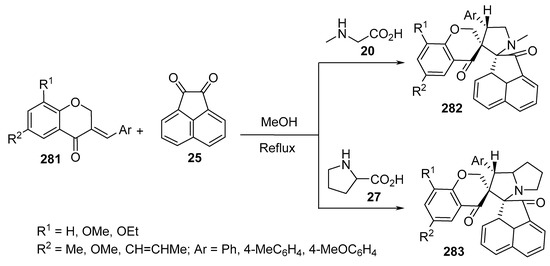
Scheme 95.
Synthesis of spiropyrrolidines 282 and 283.
A multi-component reaction of 2-ylidene-tetrahydronaphthalene-1-one 284 or (E)-3-ylidene-4-chromanone 281 with azomethine ylide formed from indenoquinoxaline-11-one (generated from ninhydrin 44 and o-phenylenediamine 43) and L-proline 27 afforded, in the presence of heteropolyacid H4[Si(W3O10)3]‒silica as a catalyst in refluxing acetonitrile, the corresponding dispiroindenoquinoxaline-pyrrolizidines 285 and 286, respectively (Scheme 96) [93].
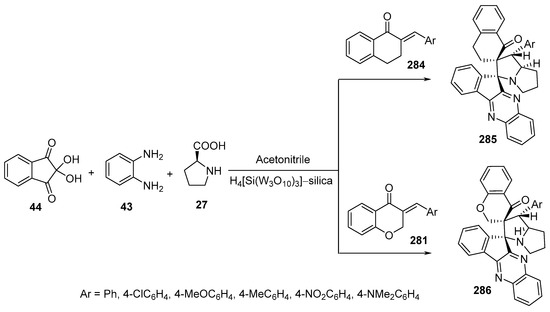
Scheme 96.
Synthesis of dispiroindenoquinoxaline-pyrrolizidines 285 and 286.
3.16. Thiochromanones
Dispiro[indene-2,2′-pyrrolidine-3′,3″-thiochromanes] 288 were obtained by reacting 3-arylidenethiochroman-4-one 287 with azomethine ylide (obtained from ninhydrin 44 and sarcosine 20) in refluxing methanol. When thioproline 22 was used instead of sarcosine 20, the corresponding dispiro derivatives of type 289 were obtained. Some of the synthesized pyrrolizidines revealed antimycobacterial properties (Mycobacterium tuberculosis H37Rv) relative to Cycloserine and Pyrimethamine (standard references). Additionally, mild antiproliferative properties against CCRF-CEM (leukemia), HT29 (ovarian), and MCF7 (breast) cancer cell lines relative to Doxorubicin (MTT assay) were observed (Scheme 97) [137].

Scheme 97.
Synthetic route towards dispiro-containing compounds 288 and 289.
3.17. Acridinones
The reaction of (E)-2-(arylidene)-3,4-dihydro-1(2H)-acridinones 290 with azomethine ylides formed from the condensation of isatin 19 and sarcosine 20 or thioproline 22 in refluxing dioxane/methanol afforded the corresponding dispirooxindolyl-[acridine-2′,3-pyrrolidine/thiapyrrolizidine]-1′-ones 291 and 292, respectively (Scheme 98) [138].
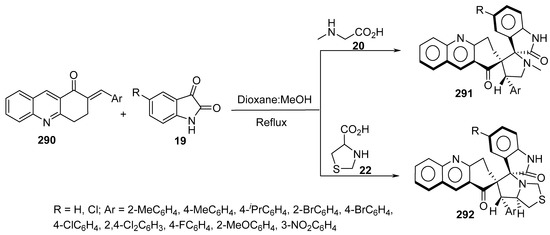
Scheme 98.
Synthesis of dispirooxindolyl-[acridine-2′,3-pyrrolidine/thiapyrrolizidine]-1′-ones 291 and 292.
Naphtho[1′,8′:1,2,3]pyrrolo[3′,2′:8,8a]azuleno[5,6-b]quinolin-14-one 293 and naphtho[1′,8′:1,2,3]thiazolo[3″,4″:1′,5′]pyrrolo[3′,2′:8]-azuleno-[5,6-b]quinolin-18-one 294 were obtained by reacting (E)-2-(arylidene)-3,4-dihydro-1(2H)-acridinone 290 with azomethine ylides generated from acenaphthoquinone 25 with sarcosine 20 or thioproline 22 in refluxing toluene, respectively (Scheme 99) [139].
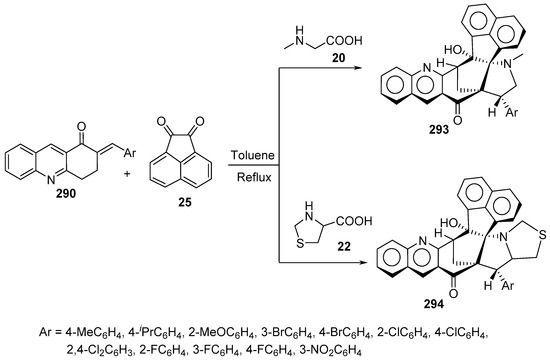
Scheme 99.
Synthesis of naphtho[1′,8′:1,2,3]pyrrolo[3′,2′:8,8a]azuleno[5,6-b]quinolin-14-ones 293 and naphtho[1′,8′:1,2,3]thiazolo[3″,4″:1′,5′]pyrrolo[3′,2′:8]azuleno-[5,6-b]quinolin-18-ones 294.
3.18. Thiazolidinones
A series of dispiro[indoline-3,2′-pyrrolidine-3′,5″-thiazolidines] of type 297, which are potential α-amylase inhibitors (useful for type-2 diabetes mellitus), were obtained through the cycloaddition of azomethine ylide (generated from glycine methyl ester 295 and isatin 19) and 5-arylidine-2-thioxothiazolidin-4-one 296 (Scheme 100) [140].
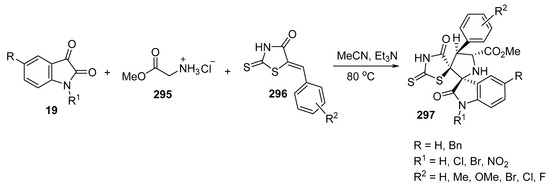
Scheme 100.
Synthesis of dispiro[indoline-3,2′-pyrrolidine-3′,5″-thiazolidines] 297.
Another group of benzo[h]quinolinyl dispiro-compounds 299–301 was obtained by reacting [5-(2′-chlorobenzo[h]quinolin-3′-yl)methylidene]-thiazolidin-2,4-dione/2-thioxothiazolidin-4-one 298 with various azomethine ylides formed from isatin 19 and different amino acids (sarcosine 20, thioproline 22, or L-proline 27) (Scheme 101) [141].
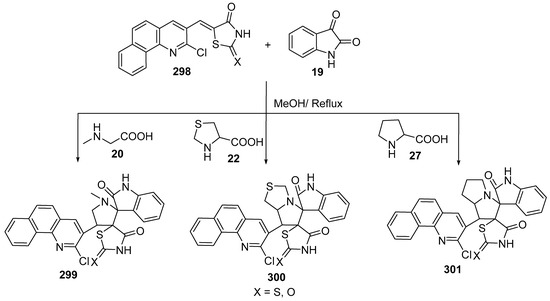
Scheme 101.
Synthesis of benzo[h]quinolinyl dispiro-compounds 299–301.
3.19. Thiazolo[3,2-a]pyrimidine-3-ones
Various (E)-arylmethylene-octahydro/decahydro cycloalka[d]thiazolo[3,2-a]pyrimidine-3-ones of type 302 reacted smoothly with azomethine ylides formed from isatin 19 and sarcosine 20 or thioproline 22 in a refluxing methanol-dioxane (1:1) mixture, thereby affording the corresponding spiro-oxindoles 303 and 304, respectively (Scheme 102) [142].
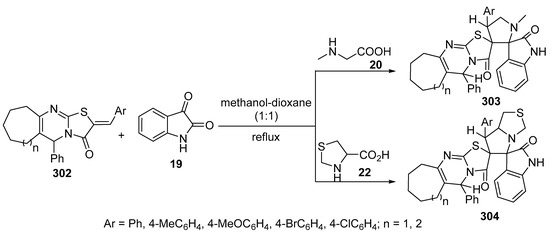
Scheme 102.
Synthesis of spiro-oxindoles 303 and 304.
3.20. Benzo[1,4]thiazines
Spiro-oxindoles 306 and 307 and spiro-acenaphthylen-1-ones 308 and 309 were synthesized via a multicomponent reaction of 2-(4-methylbenzylidene)-4H-benzo[1,4]thiazin-3-one 305 and azomethine ylides derived from isatin 19 or acenaphthenequinone 25 with sarcosine 20 or L-proline 27 in refluxing toluene (Scheme 103) [143].

Scheme 103.
Synthesis of spiro-oxindoles and spiro-acenaphthylen-1-ones 306–309.
4. Cyclic Unsaturated 2π-Electron Components
4.1. Non-Aromatic Cyclc 2π-Electron Components
4.1.1. Alicyclic Unsaturated 2π-Electron Components
Intermolecular Cycloaddition Reactions
- Cyclopentenone
The reaction of azomethine ylide generated from benzyl(methoxymethyl)(trimethylsilylmethyl)amine 1 with cyclopentenone 310 afforded bicyclic ketone 311 via an addition to the C2-C3 unsaturated linkage. Some analogs of 307 exhibited histamine H3 receptor antagonists that are responsible for the production and regulation of histamine and other neurotransmitters (Scheme 104) [144].
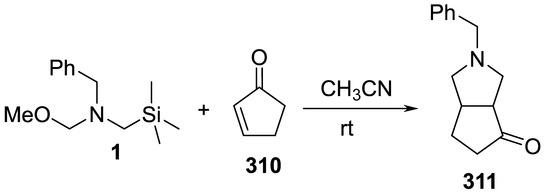
Scheme 104.
Synthesis of bicyclic ketone 311.
- 1,4-Naphthoquinone
Spirooxindoles of type 313 were obtained by the cycloaddition of azomethine ylides, formed from isatin 19 and sarcosine 20, with 1,4-naphthoquinone 312 in refluxing ethanol (Scheme 105). Some of the synthesized compounds showed antibacterial activities against Staphylococcus aureus, S. aureus (MRSA), Enterobacter aerogens, Micrococcus luteus, Proteus vulgaris, Klebsiella pneumonia, Salmonella typhimurium, and Salmonella paratyphi-B, and antifungal activities against Malassesia pachydermatis, Candida albicans, and Botyritis cinerea relative to Streptomycin and Ketoconazole (standard references) [145].
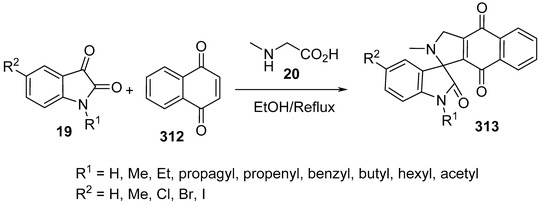
Scheme 105.
Synthesis of spiro-indoles 313.
Further spiro[benzo[f]isoindole-1,3′-indolines] of type 315 were synthesized by the cycloaddition of azomethine ylides (formed from isatin 19 and 2-(3-methyl-5-styrylisoxazol-4-ylamino)acetic acids 314) and 1,4-naphthoquinone 312 using ceric ammonium nitrate (CAN) as a catalyst (Scheme 106). Some of the products showed anti-inflammatory (determined via rat carrageen paw edema assay) and analgesic (determined via acetic acid writing protocol) properties relative to Ibuprofen and Diclofenac as references, respectively [146].
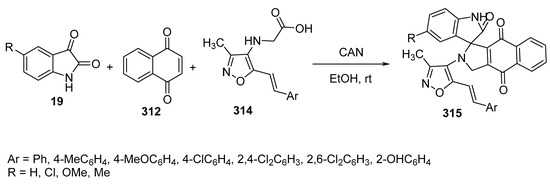
Scheme 106.
Synthesis of spiro[benzo[f]isoindole-1,3′-indolines] 315.
Tricyclic benzo[f]isoindole-4,9-dione-1-carboxylate 317 was obtained by reacting 1,4-naphthoquinone 312 with azomethine ylide generated from sarcosine ethyl ester hydrochloride 103 and paraformaldehyde 316 in the presence of iodine and sodium bicarbonate as a base in refluxing acetonitrile (Scheme 107) [147].

Scheme 107.
Synthesis of benzo[f]isoindole-4,9-dione-1-carboxylate 317.
Intramolecular Cycloaddition Reactions
The azatricyclic [6-5-7] ring system 320 was created via the intramolecular [3+2]-cycloaddition reaction of azomethine ylide generated from aldehyde 318 and N-(trimethylsilyl)methyl iminium salt 319 in the presence of a catalytic amount of phosphoric acid in DMF as a solvent (Scheme 108) [148].

Scheme 108.
Synthesis of azatricyclic [6-5-7] ring system 320.
4.2. Aromatic Cyclic Unsaturated 2π-Electron Components
Azomethine ylide’s cycloaddition to aromatic 2π-electron components (aromatic or heteroaromatic) was reviewed in [149].
A series of benzoazepine-fused isoindolines of type 322 were obtained through thermal azomethine ylide-based cycloaddition of benzaldehydes bearing 3,5-dinitrophenyl 321 and N-substituted α-amino acids. The reaction was assumed to proceed through a regioselective dearomatizing [3+2] cycloaddition with the removal of HNO2, thus yielding the aromatic final product 322 (Scheme 109) [150].
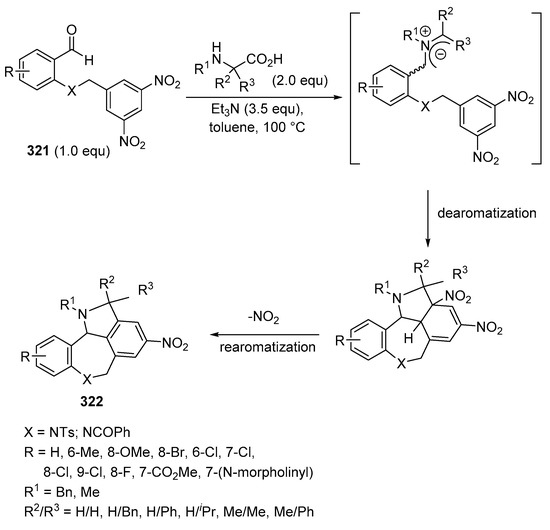
Scheme 109.
Synthesis of benzoazepine-fused isoindolines 322.
Nitro-substituted benzenes 323–329 underwent [3+2] cycloaddition of azomethine ylide derived from (N-(methoxymethyl)-N-(trimethylsilyl-methyl)-benzylamine) 1, affording the pyrrolidinyl cycloadducts 330–337 (Scheme 110) [151].
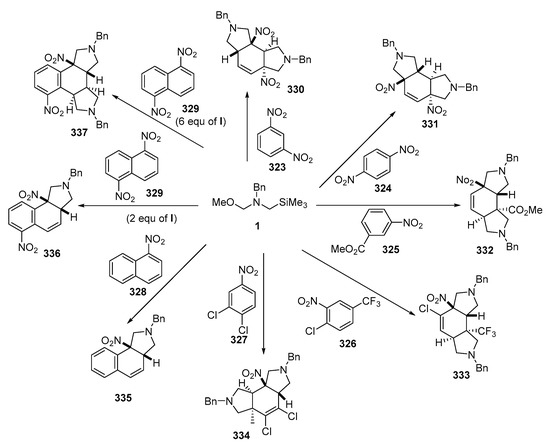
Scheme 110.
Synthesis of pyrrolidinyl cycloadducts 330–337.
Pyrrolo[3,4-c]pyridines 339 were obtained through azomethine ylide’s (formed from sarcosine and paraformaldehyde 316) cycloaddition with 3-nitropyridines 338 in refluxing toluene (Scheme 111) [152].
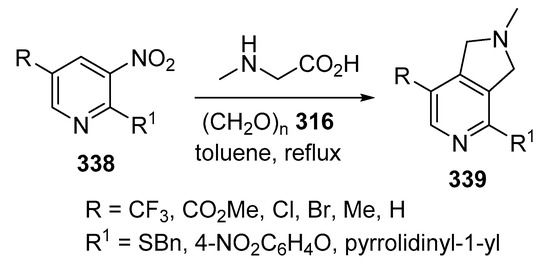
Scheme 111.
Synthesis of pyrrolo[3,4-c]pyridines 339.
Analogously, heterocyclic compounds bearing nitro groups 340–345 and 352–356 underwent a cycloaddition reaction with azomethine ylide derived from (N-(methoxymethyl)-N-(trimethylsilyl-methyl)-benzylamine) 1, affording the pyrrolidinyl-containing analogs 346–351 and 357–361 (Scheme 112 and Scheme 113) [151,153].
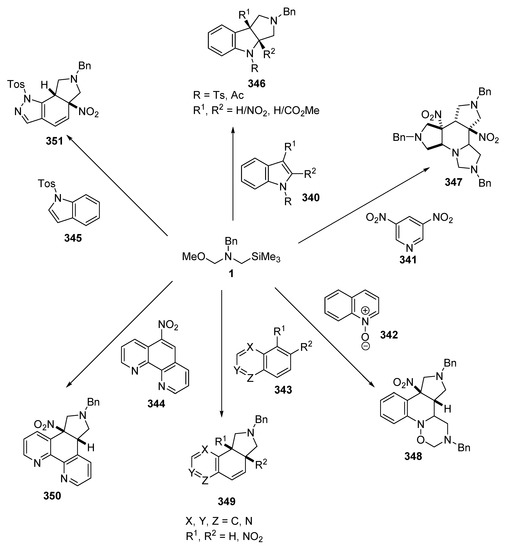
Scheme 112.
pyrrolidinyl-fused heterocycles 346–351.
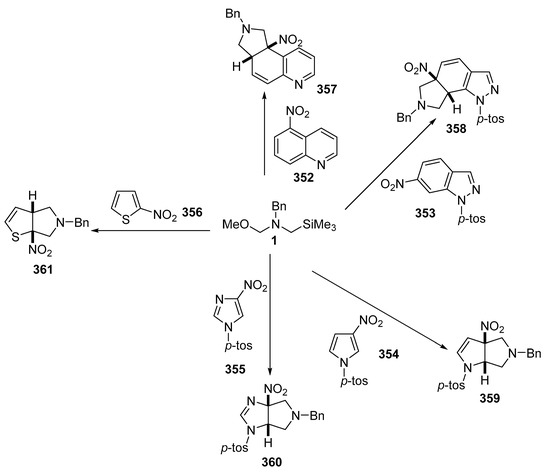
Scheme 113.
pyrrolidinyl-fused heterocycles 357–361.
Double cycloadducts of type 363 were obtained through azomethine ylide (formed from sarcosine and paraformaldehyde 316) with meta-dinitro-containing nitrogenous heterocycles 362 in refluxing toluene (Scheme 114) [154].
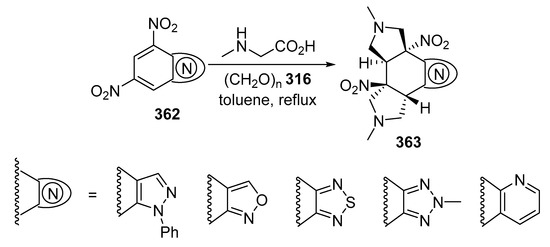
Scheme 114.
Synthesis of double cycloadducts 363 from meta-dinitro-containing nitrogenous heterocycles of type 362.
4-Chloro-5,7-dinitro-4-benzofurazan bearing indolyl heterocycle 364 underwent azomethine ylide (formed from the condensation of sarcosine and paraformaldehyde 316) cycloaddition in refluxing benzene, affording the corresponding tetrahydro-5aH-[1,2,5]oxa-diazolo[3,4-e]isoindole 365. Alternatively, conducting the reaction in refluxing MeCN afforded a mixture of 366 and 367. Similarly, analogs with a pyrrolidinyl function (366 and 367) were obtained upon reacting the appropriate analog of 365 in MeCN at room temperature (in the darkness) (Scheme 115) [155].
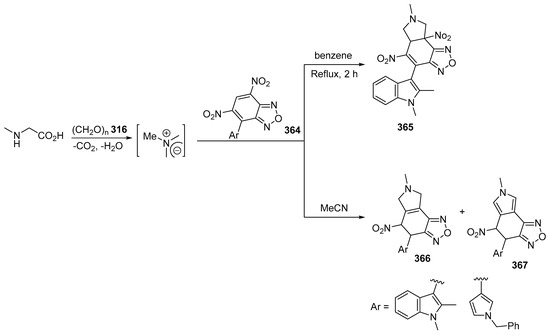
Scheme 115.
Synthesis of [1,2,5]oxa-diazolo[3,4-e]isoindole 365–367.
The cycloaddition reaction of azomethine ylide derived from (N-(methoxymethyl)-N-(trimethylsilyl-methyl)-benzylamine) with 4-nitrobenzofuroxan 368 afforded either mono 369 or bis 370 cycloadducts based via the substitution of the starting benzofuroxan at the 7-position (Scheme 116) [156].
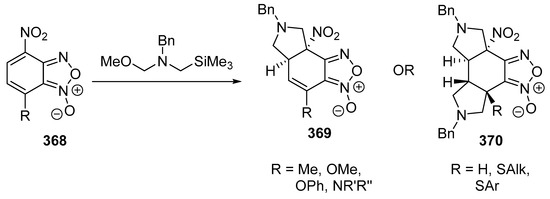
Scheme 116.
Synthesis of mono-369 or biscycloadducts 370 of 4-nitrobenzofuroxans.
4.3. Heterocyclic Unsaturated 2π-Electron Components
4.3.1. Maleimides
Spiro[3H-indole-3,2′(1′H)-pyrrolo[3,4-c]pyrroles] of type 372 were obtained in good yields by the cycloaddition of azomethine ylide (formed from sarcosine 20 and isatin 19) to the C3-C4 unsaturated bond of maleimide 371. Some of the synthesized compounds revealed promising to moderate antiproliferative properties against HEPG2 (liver), HCT116 (colon), and MCF7 (breast) cancer cell lines (SRB technique) relative to Doxorubicin (standard reference drug) (Scheme 117) [157].
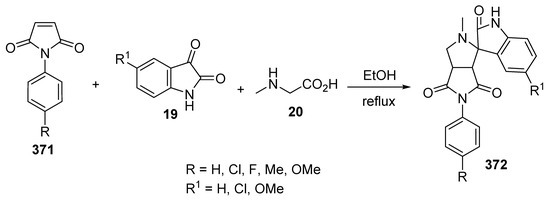
Scheme 117.
Synthetic route towards spiro[3H-indole-3,2′(1′H)-pyrrolo[3,4-c]pyrroles] 372.
A microwave-assisted multi-component reaction of maleimide 371 with azomethine ylide produced from sarcosine 20 and ninhydrin 44 stereoselectively afforded spiro[indene-2,1′-pyrrolo[3,4-c]pyrroles] 373. Some of the products showed promising antimycobacterial (M. tuberculosis H37Rv) properties relative to Cycloserine (Scheme 118) [158].
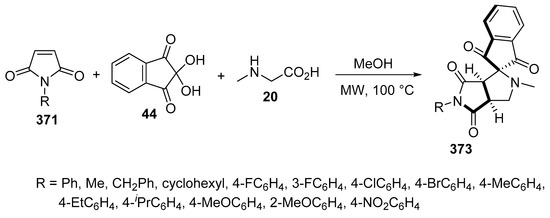
Scheme 118.
Synthetic route towards spiro[indene-2,1′-pyrrolo[3,4-c]pyrroles] 373.
In another reaction of N-phenylmaleimide 371 with azomethine ylides generated from 2-chloro-quinoline-3-carbaldehydes 374 and sarcosine 20, two isomeric cycloadducts, namely, 1,4-diaza-bicyclo[3.3.0]octanes 375 and 376, were formed (Scheme 119) [159].

Scheme 119.
Synthesis of the two isomeric cycloadducts 5-(2-chloroquinolin-3-yl)-1,4-diaza-2,6-dioxo-4-methyl-1-phenyl-bicyclo[3.3.0]octanes 375 and 376.
Tetracyclic pyrroloisoquinolines of type 378 were synthesized by the reaction of azomethine ylides, formed from isoquinolines 11 and phenacyl bromide 377, with N-arylmaleimides 371 in the presence of cetyl trimethyl ammonium bromide (CTAB) (Scheme 120) [160].
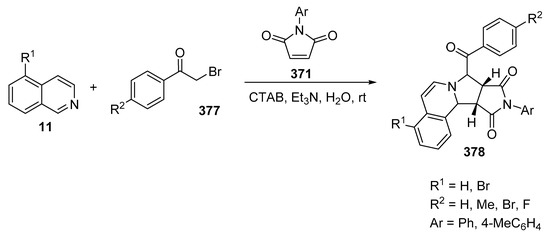
Scheme 120.
Synthesis of pyrroloisoquinolines 378.
Bicyclic hexahydropyrrolo[3,4-c]pyrrole-1-carboxylates 380 and 381 were obtained by reacting N-phenylmaleimide 371 with a series of azomethine ylides generated in situ from sulfanyl-substituted imines of glycine esters 379 (Scheme 121) [161]. Some of the synthesized diastereomeric compounds showed antioxidant activity relative to Nordihydroguaiaretic acid and Trolox [161].
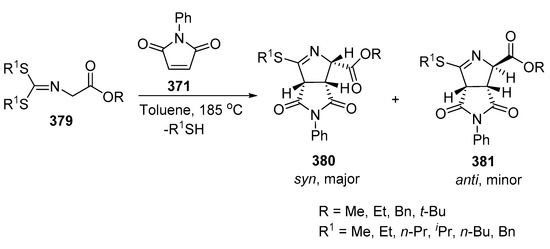
Scheme 121.
Synthesis of hexahydropyrrolo[3,4-c]pyrrole-1-carboxylates 380 and 381.
Another reaction of maleimide 371 with pyrazole-4-carbaldehyde 382 and α-amino acid ester 383, proceeding via azomethine intermediates in refluxing toluene, afforded the corresponding pyrazolylpyrrolopyrrole 384 (Scheme 122) [162].
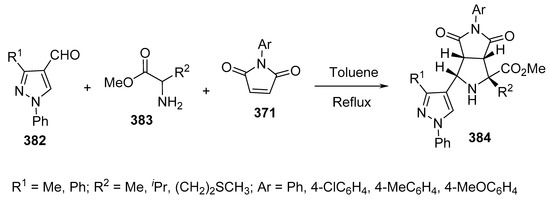
Scheme 122.
Synthesis of pyrazolylpyrrolopyrroles 384.
Isomeric pyrrolo[3,4-a]pyrrolizines 386 and 387 were synthesized by the cycloaddition of maleimide 371 with azomethine ylides formed from 3-alkylsulfanyl-2-arylazo-3-(pyrrolidin-1-yl)acrylonitriles of type 385 in refluxing benzene (Scheme 123) [163].
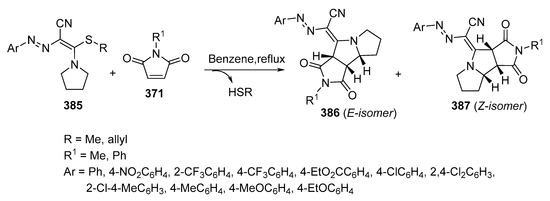
Scheme 123.
Synthesis of pyrrolo[3,4-a]pyrrolizines 386, 387.
4.3.2. Maleic Anhydride
3,4-Dihydropyrrolo[2,1-a]isoquinoline 389 was obtained through the reaction of maleic anhydride 388 with azomethine ylide formed via the oxidation of tetrahydroisoquinoline 53 by dirhodium(II)caprolactamate [Rh2(cap)4] in the presence of tert-butyl hydroperoxide (TBHP) (Scheme 124) [37].

Scheme 124.
Synthesis of 3,4-dihydropyrrolo[2,1-a]isoquinoline 389.
4.3.3. Benzo[b]thiophene-1,1-dioxide
The reaction of benzo[b]thiophene-1,1-dioxide 390 with a thermally generated azomethine ylide from aziridines 391 in refluxing dry benzene afforded the cycloadducts of type 392 (Scheme 125) [164].
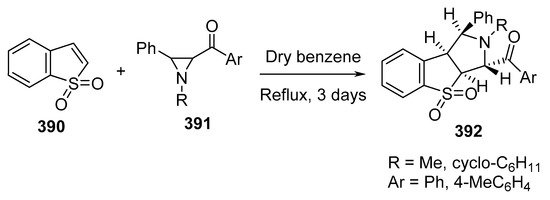
Scheme 125.
Synthesis of cycloadducts 392.
Three isomeric cycloadducts, 393–395, were obtained by reacting benzo[b]thiophene-1,1-dioxide 390 with azomethine ylides generated from sarcosine 20 and aldehydes 13 in refluxing toluene (Scheme 126) [164].

Scheme 126.
Synthesis of cycloadducts 393–395.
4.3.4. Benzo[c]isoxazole and Benzo[c]isothiazole
Decahydroisoxazolo[3,4-e]pyrrolo[3,4-g]isoindole 397 and its isothiazolo-derivative 399 were synthesized by the [3+2]-cycloaddition of benzo[c]isoxazole 396 and benzo[c]isothiazole 398, respectively, to azomethine ylide generated from sarcosine 20 and paraformaldehyde 316 in toluene under reflux conditions (Scheme 127) [165].
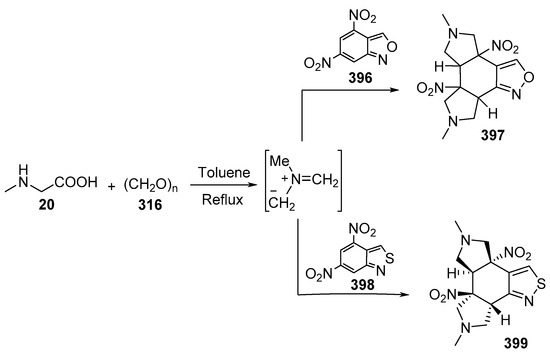
Scheme 127.
Synthesis of decahydroisoxazolo[3,4-e]pyrrolo[3,4-g]isoindole 397 and decahydroisothiazolo[3,4-e]pyrrolo[3,4-g]isoindole 399.
4.3.5. Indoles
Hexahydropyrrolo[3,4-b]indoles of type 402 were synthesized by reacting 3-nitroindoles of type 400 with azomethine ylides formed from α-amino acids (sarcosine 20 or N-benzylglycine 401) and paraformaldehyde 316 (Scheme 128) [166].
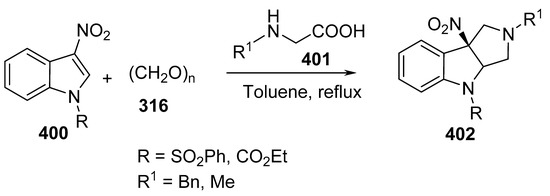
Scheme 128.
Synthesis of hexahydropyrrolo[3,4-b]indoles 402.
4.3.6. Lactones
The reaction of α,β-unsaturated lactones of type 403 with azomethine ylide formed from N-methyl isatin 19 and proline 27 in refluxing toluene afforded the corresponding pyrrolidinyl-spirooxindole lactones of type 404 in high yield (Scheme 129) [167].
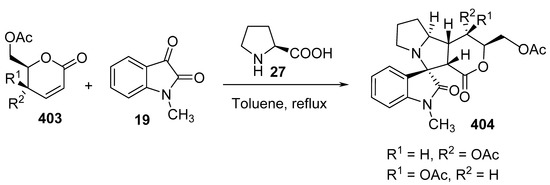
Scheme 129.
Synthesis of pyrrolidinyl-spirooxindole lactones 404.
Another glucosyl α,ß-unsaturated-7,3-lactone 405 reacted with azomethine ylides generated from isatin 19 and secondary amino acids (proline 27, thioproline 22 or pipacolinic acid 142) in refluxing dry toluene under N2 (inert atmosphere) to produce glucosylspiro-oxindoles 406–408 in a highly regio- and stereoselective manner (Scheme 130) [168].
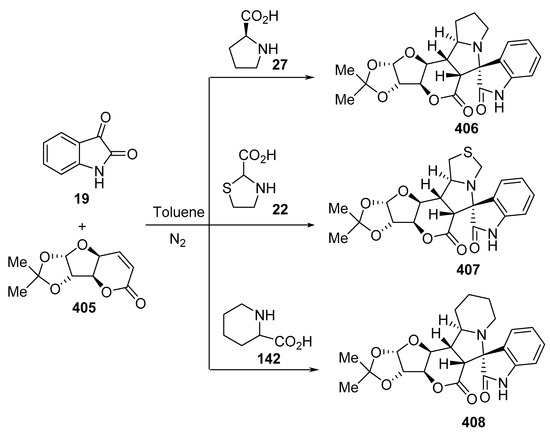
Scheme 130.
Synthesis of glucosyl-spirooxindoles 406–408.
4.3.7. Chromenes
3-Nitrochromenes of type 409 underwent a reaction with azomethine ylides formed from isatin 19 and amino acids (sarcosine 20, proline 27, or pipacolinic acid 142) in refluxing toluene to afford the corresponding spiropyrrolidine/spiro-pyrrolizidine/spiroindolizidine-oxindoles 410 and 411 (Scheme 131) [169].
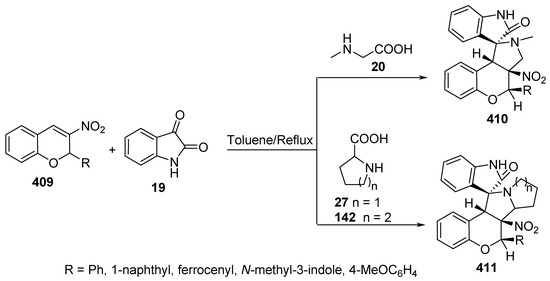
Scheme 131.
Synthesis of spiropyrrolidine/spiropyrrolizidine/spiroindolizidine-oxindoles 410 and 411.
Spiropyrrolidine-oxindole carbohydrate 413 was synthesized by the reaction of glycol 3-nitrochromene 412 with azomethine ylide formed from isatin 19 and sarcosine 20 in refluxing acetonitrile (Scheme 132) [170].
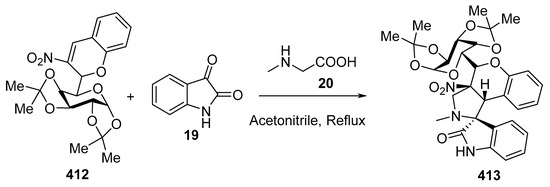
Scheme 132.
Synthesis of spiropyrrolidine-oxindole carbohydrate 413.
Isomeric benzopyrano[3,4-c]pyrrolidines 415 and 416 were obtained via the cycloaddition of 3-nitro-2-trihalomethyl-2H-chromenes 414 to azomethine ylide generated from sarcosine 20 and paraformaldehyde 316 in refluxing toluene (Scheme 133) [171].

Scheme 133.
Synthesis of benzopyrano[3,4-c]pyrrolidines 415 and 416.
However, the reaction of 2-aryl-3-nitrochromenes 409 with azomethine ylides formed from paraformaldehyde 316 and sarcosine 20 or N-benzyl-glycine 401 in toluene under refluxing conditions afforded the corresponding 3a-nitro-4-aryl benzopyrano[3,4-c]pyrrolidines of type 417 in high yields. Further, 1H,1H-NOE spectroscopic studies supported the structure of 417 (Scheme 134) [172].
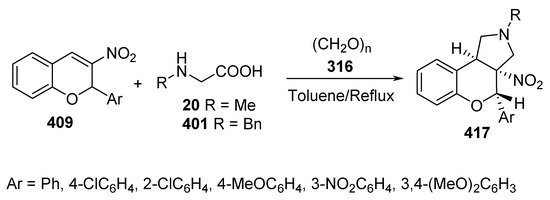
Scheme 134.
Synthesis of 3a-nitro-4-aryl benzopyrano[3,4-c]pyrrolidines 417.
4.3.8. Coumarins
A cycloaddition strategy for the synthesis of [1]-benzopyrano[3,4-c]pyrrolidines 419 and 420 was based on the reaction of 3-substituted coumarins of type 418 and in situ-generated azomethine ylides formed from sarcosine 20 or proline 27 with paraformaldehyde 316 in refluxing benzene (Scheme 135) [173,174].
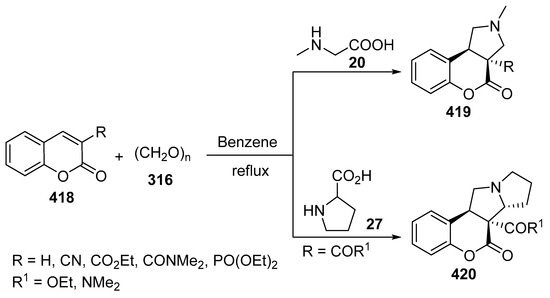
Scheme 135.
Synthesis of [1]-benzopyrano[3,4-c]pyrrolidines 419, 420.
The reaction of 3-acetyl-2H-chromen-2-one 421 with azomethine ylides generated from isatin 19 and sarcosine 20 in refluxing toluene afforded the corresponding chromeno[3,4-c]spiropyrrolidine-oxindoles of type 422, while the analogous reaction in methanol gave chromeno[3,4-c]spiropyrrolidine-oxindole derivatives of type 423 (Scheme 136) [175].
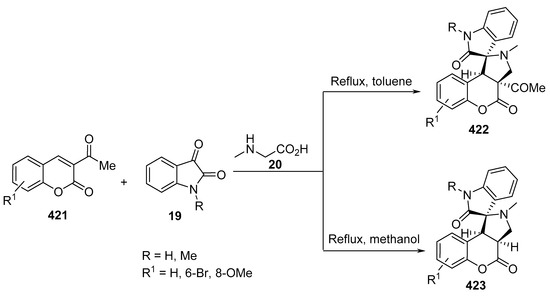
Scheme 136.
Synthesis of chromeno[3,4-c]spiropyrrolidine-oxindoles 422 and 423.
Mixtures of isomeric benzopyrano[3,4-c]pyrrolidines 425 and 426 were obtained from the reaction of coumarin 418 with azomethine ylides formed from α-iminoester 424 in the presence of silver(I)-trifluoroacetate (AgTFA) in tetrahydrofuran at room temperature (Scheme 137) [176].
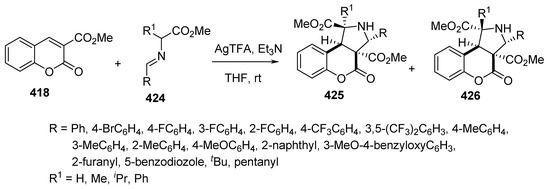
Scheme 137.
Synthesis of benzopyrano[3,4-c]pyrrolidines 425 and 426.
4.3.9. Chromones
Benzopyranopyrrolidine derivatives of type 428 were synthesized by the cycloaddition of 3-substituted chromones of type 427 with azomethine ylide generated from sarcosine 20 and paraformaldehyde 316 in benzene under refluxing conditions (Scheme 138) [177].

Scheme 138.
Synthesis of benzopyranopyrrolidines 428.
Udry et al. described the synthesis of enantiomerically pure cycloadducts (431a, 431b) from stabilized azomethine ylides of type 430 and sugar-derived enones (429a and 429b) through the [3+2]-cycloaddition reaction in the presence of silver acetate (AgOAc) and DBU in acetonitrile. The cycloadducts were further used to synthesize enantiomeric polyhydroxyalkylpyrrolidines as potential β-galactofuranosidase inhibitors (Scheme 139) [178].
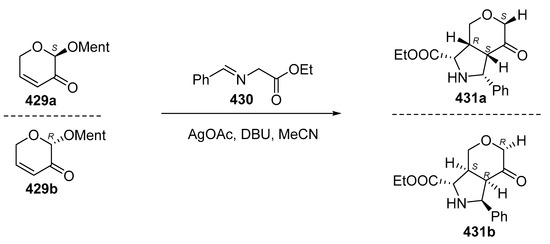
Scheme 139.
Synthesis of enantiomeric pyrrolidines 431.
4.3.10. Isatoic Anhydride
1,3-Benzodiazepin-5-ones of type 433 were obtained through azomethine ylide (formed from (N-(methoxymethyl)-N-(trimethylsilyl-methyl)-benzylamine) 1 cycloaddition to isatoic anhydride 432 in trifluoroacetic acid in the presence of molecular sieves (4 Å) (Scheme 140) [179].

Scheme 140.
Synthesis of 1,3-benzodiazepin-5-one 433.
5. Conclusions and Outlook
Among various methods, the [3+2]-cycloaddition reaction of azomethine ylides is one of the most adopted protocols for the formation of pyrrolidine and pyrrole systems. The chemistry of azomethine ylides has progressed significantly in the last two decades. Azomethine ylides have been used for the synthesis of many stereoselective natural products, core ring systems of natural products, and several bioactive molecules containing multiple chiral centers. The cycloaddition of a three-atom component to an appropriate unsaturated substrate, namely, the unsaturated 2π-electron component, is the most embraced approach to the synthesis of five-membered heterocyclic compounds. By using various unsaturated 2π-electron components in reaction with in situ-generated azomethine ylides, a plethora of pyrrolidinyl-containing heterocycles can be obtained in a highly regio- and stereoselective manner. As a result of intermolecular cycloadditions, one new ring with a defined stereochemistry is formed; however, when the three-atom component and the substrate are part of the same molecule, the cycloaddition is intramolecular and leads to a more complex molecular architecture that is difficult to access by other routes, namely, through the use of new bicyclic systems.
This review summarizes the synthesis of some of the most important compounds resulting from the [3+2]-cycloaddition reactions of azomethine ylides with various olefinic (acyclic, alicyclic/heterocyclic, and exocyclic) unsaturated 2π-electron components and highlights their potential therapeutic significance. We believe the compiled subject will develop interest within this field among the research community and encourage them to develop a wider variety of asymmetric [3+2]-cycloaddition reaction strategies for the synthesis of complex molecules.
Funding
This work was supported financially by National Research Centre, Egypt, project ID: 12060101.
Institutional Review Board Statement
Not applicable.
Informed Consent Statement
Not applicable.
Data Availability Statement
Not applicable.
Acknowledgments
We thank the Department of Chemistry and Physics at Augusta University for its support.
Conflicts of Interest
The authors declare no conflict of interest.
References
- Huisgen, R. 1,3-Dipolar Cycloaddition Chemistry; Padwa, A., Ed.; John Wiley & Sons: Hoboken, NJ, USA, 1984; Volume 1, Chapter 1; pp. 3–5. [Google Scholar]
- Rios-Gutierrez, M.; Domingo, L.R. Unravelling the mysteries of the [3+2] cycloaddition reactions. Eur. J. Org. Chem. 2019, 2019, 267–282. [Google Scholar] [CrossRef]
- William Lown, J. 1,3-Dipolar Cycloaddition Chemistry; Padwa, A., Ed.; John Wiley & Sons: Hoboken, NJ, USA, 1984; Volume 1, Chapter 6; pp. 657, 726. [Google Scholar]
- Coldham, I.; Hufton, R. Intramolecular Dipolar Cycloaddition Reactions of Azomethine Ylides. Chem. Rev. 2005, 105, 2765–2809. [Google Scholar] [CrossRef] [PubMed]
- Song, G.; Chen, D.; Su, Y.; Han, K.; Pan, C.-L.; Jia, A.; Li, X. Isolation of Azomethine Ylides and Their Complexes: Iridium(III)-Mediated Cyclization of Nitrone Substrates Containing Alkynes. Angew. Chem. Int. Ed. 2011, 50, 7791–7796. [Google Scholar] [CrossRef] [PubMed]
- Lee, D.J.; Han, H.S.; Shin, J.; Yoo, E.J. Multicomponent [5+2] Cycloaddition Reaction for the Synthesis of 1,4-Diazepines: Isolation and Reactivity of Azomethine Ylides. J. Am. Chem. Soc. 2014, 136, 11606–11609. [Google Scholar] [CrossRef]
- Molteni, G.; Silvani, A. Spiro-2-oxindoles via 1,3-dipolar cycloadditions. A decade update. Eur. J. Org. Chem. 2021, 2021, 1653–1675. [Google Scholar] [CrossRef]
- Adrio, J.; Carretero, J.C. Stereochemical diversity in pyrrolidine synthesis by catalytic asymmetric 1,3-dipolar cycloaddition of azomethine ylides. Chem. Comm. 2019, 55, 11979–11991. [Google Scholar] [CrossRef]
- Bdiri, B.; Zhao, B.-J.; Zhou, Z.-M. Recent advances in the enantioselective 1,3-dipolar cycloaddition of azomethine ylides and dipolarophiles. Tetrahedron Asymm. 2017, 28, 876–899. [Google Scholar] [CrossRef]
- Tang, S.; Zhang, X.; Sun, J.; Niu, D.; Chruma, J.J. 2-Azaallyl Anions, 2-Azaallyl Cations, 2-Azaallyl Radicals, and Azomethine Ylides. Chem. Rev. 2018, 118, 10393–10457. [Google Scholar] [CrossRef]
- Dondas, H.A.; de Gracia Retamosa, M.; Sansano, J.M. Current Trends towards the Synthesis of Bioactive Heterocycles and Natural Products Using 1,3-Dipolar Cycloadditions (1,3-DC) with Azomethine Ylides. Synthesis 2017, 49, 2819–2851. [Google Scholar] [CrossRef]
- Meyer, A.G.; Ryan, J.H. 1,3-Dipolar Cycloaddition Reactions of Azomethine Ylides with Carbonyl Dipolarophiles Yielding Oxazolidine Derivatives. Molecules 2016, 21, 935. [Google Scholar] [CrossRef]
- Fang, X.; Wang, C.-J. Catalytic asymmetric construction of spiropyrrolidines via 1,3-dipolar cycloaddition of azomethine ylides. Org. Biomol. Chem. 2018, 16, 2591–2601. [Google Scholar] [CrossRef] [PubMed]
- Arrastia, I.; Arrieta, A.; Cossio, F.P. Application of 1,3-Dipolar Reactions between Azomethine Ylides and Alkenes to the Synthesis of Catalysts and Biologically Active Compounds. Eur. J. Org. Chem. 2018, 2018, 5889–5904. [Google Scholar] [CrossRef] [PubMed]
- Wei, L.; Chang, X.; Wang, C.-J. Catalytic Asymmetric Reactions with N-Metallated Azomethine Ylides. Acc. Chem. Res. 2020, 53, 1084–1100. [Google Scholar] [CrossRef] [PubMed]
- Verma, S.; George, J.; Singh, S.; Pardasani, P.; Pardasani, R. [3+2] Cycloaddition reactions of thioisatin with thiazolidine-2-carboxylic acid: A versatile route to new heterocyclic scaffolds. Org. Med. Chem. Lett. 2011, 1, 6. [Google Scholar] [CrossRef] [PubMed]
- Lashgari, N.; Ziarani, G.M. Synthesis of heterocyclic compounds based on isatin through 1,3-dipolar cycloaddition reactions. ARKIVOC 2012, 2012, 277–320. [Google Scholar] [CrossRef]
- Padwa, A.; Pearson, W.H. (Eds.) The chemistry of heterocyclic compounds. In Synthetic Applications of 1,3-Dipolar Cycloaddition Chemistry toward Heterocycles and Natural Products; John Wiley & Sons: Hoboken, NJ, USA, 2002; Volume 59. [Google Scholar]
- Martina, K.; Tagliapietra, S.; Veselov, V.V.; Cravotto, G. Green protocols in heterocycle syntheses via 1,3-dipolar cycloadditions. Front. Chem. 2019, 7, 95. [Google Scholar] [CrossRef]
- Grafton, M.; Mansfield, A.C.; Fray, M.J. [3+2] Dipolar cycloadditions of an unstabilised azomethine ylide under continuous flow conditions. Tetrahedron Lett. 2010, 51, 1026–1029. [Google Scholar] [CrossRef]
- Boruah, M.; Konwar, D.; Sharma, S.D. KF/Al2O3 mediated 1,3-dipolar cycloaddition of azomethine ylides: A novel and convenient procedure for the synthesis of highly substituted pyrrolidines. Tetrahedron Lett. 2007, 48, 4535–4537. [Google Scholar] [CrossRef]
- Belfaitah, A.; Isly, M.; Carboni, B. 1,3-Dipolar cycloadditions of azomethine ylides to alkenylboronic esters. Access to substituted boron analogues of β-proline and 3-hydroxypyrrolidines. Tetrahedron Lett. 2004, 45, 1969–1972. [Google Scholar] [CrossRef]
- Han, Y.; Hou, H.; Fu, Q.; Yan, C.-G. One-pot two-step tandem reactions for selective synthesis of pyrrolo[2,1-a]isoquinolines and dihydro-, tetrahydro-derivatives. Tetrahedron 2011, 67, 2313–2322. [Google Scholar] [CrossRef]
- Poomathi, N.; Mayakrishnan, S.; Muralidharan, D.; Perumal, P.T. A facile access to novel spiroxindole fused pyrrolidine and thiazolo pyrrolidine benzimidazole derivatives via 1,3-dipolar cycloaddition reaction. Tetrahedron Lett. 2015, 56, 721–726. [Google Scholar] [CrossRef]
- Dandia, A.; Jain, A.K.; Laxkar, A.K.; Bhati, D.S. A highly efficient protocol for the regio- and stereo-selective synthesis of spiro pyrrolidine and pyrrolizidine derivatives by multicomponent reaction. Tetrahedron Lett. 2013, 54, 3180–3184. [Google Scholar] [CrossRef]
- Aksenov, A.V.; Aksenov, D.A.; Arutiunov, N.A.; Aksenov, N.A.; Aleksandrova, E.V.; Zhao, Z.; Du, L.; Kornienko, A.; Rubin, M. Synthesis of Spiro [indole-3, 5′-isoxazoles] with Anticancer Activity via a Formal [4+1]-Spirocyclization of Nitroalkenes to Indoles. J. Org. Chem. 2019, 84, 7123–7137. [Google Scholar] [CrossRef] [PubMed]
- Żmigrodzka, M.; Sadowski, M.; Kras, J.; Dresler, E.; Demchuk, O.M.; Kula, K. Polar [3+2] cycloaddition between N-methyl azomethine ylide and trans-3, 3, 3-trichloro-1-nitroprop-1-ene. Sci. Radices 2022, 1, 26–35. [Google Scholar] [CrossRef]
- Żmigrodzka, M.; Dresler, E.; Hordyjewicz-Baran, Z.; Kulesza, R.; Jasiński, R. Synthesis and chemical properties of 3-alkoxycarbonylchromones and 3-alkoxalylchromones. Chem. Heter. Comp. 2017, 53, 1161–1162. [Google Scholar] [CrossRef]
- Seki, M.; Tsuruta, O.; Tatsumi, R.; Soejima, A. Synthesis and biological evaluation of pyrrolidine derivatives as novel and potent sodium channel blockers for the treatment of ischemic stroke. Bioorg. Med. Chem. Lett. 2013, 23, 4230–4234. [Google Scholar] [CrossRef]
- Sun, H.; Wang, X.; Chen, Y.; Ouyang, L.; Liu, J.; Zhang, Y. Efficient construction of highly functionalized endo’-selective spiro[pyrrolidin-2,3’-oxindoles] via a regioselective 1,3-dipolar cycloaddition reaction between 3-amino oxindoles as azomethine ylide precursors and nitroalkenes. Tetrahedron Lett. 2014, 55, 5434–5438. [Google Scholar] [CrossRef]
- Alimohammadi, K.; Sarrafi, Y.; Tajbakhsh, M.; Yeganegi, S.; Hamzehloueian, M. An experimental and theoretical investigation of the regio- and stereoselectivity of the polar [3+2] cycloaddition of azomethine ylides to nitrostyrenes. Tetrahedron 2011, 67, 1589–1597. [Google Scholar] [CrossRef]
- De Silva, N.H.; Pyreddy, S.; Blanch, E.W.; Hügel, H.M.; Maniam, S. Microwave-assisted rapid synthesis of spirooxindole-pyrrolizidine analogues and their activity as anti-amyloidogenic agents. Bioorg. Chem. 2021, 114, 105128. [Google Scholar] [CrossRef]
- Kumar, R.S.; Almansour, A.I.; Arumugam, N.; Mohammad, F.; Kotresha, D.; Menéndez, J.C. Spirooxindole-pyrrolidine heterocyclic hybrids promotes apoptosis through activation of caspase-3. Bioorg. Med. Chem. 2019, 27, 2487–2498. [Google Scholar] [CrossRef]
- Arumugam, N.; Almansour, A.I.; Kumar, R.S.; Alaqeel, S.I.; Krishna, V.S.; Sriram, D. Anti-tubercular activity of novel class of spiropyrrolidine tethered indenoquinoxaline heterocyclic hybrids. Bioorg. Chem. 2020, 99, 103799. [Google Scholar] [CrossRef] [PubMed]
- Almansour, A.I.; Arumugam, N.; Kumar, R.S.; Kotresha, D.; Manohar, T.S.; Venketesh, S. Design, synthesis and cholinesterase inhibitory activity of novel spiropyrrolidine tethered imidazole heterocyclic hybrids. Bioorg. Med. Chem. Lett. 2020, 30, 126789. [Google Scholar] [CrossRef] [PubMed]
- Arumugam, N.; Raghunathan, R. Synthesis of highly functionalized β-lactam substituted pyrroloisoquinoline and indolizinoindole system by sequential intermolecular 1,3-dipolar cycloaddition reaction and Pictet-Spengler cyclization. Tetrahedron 2010, 66, 969–975. [Google Scholar] [CrossRef]
- Wang, H.-T.; Lu, C.-D. Synthesis of 3,4-dihydropyrrolo[2,1-a]isoquinolines based on [3+2] cycloaddition initiated by Rh2(cap)4-catalyzed oxidation. Tetrahedron Lett. 2013, 54, 3015–3018. [Google Scholar] [CrossRef]
- Thangamani, A. Regiospecific synthesis and biological evaluation of spirooxindolopyrrolizidines via [3+2] cycloaddition of azomethine ylide. Eur. J. Med. Chem. 2010, 45, 6120–6126. [Google Scholar] [CrossRef]
- Kaur, A.; Singh, B.; Vyas, B.; Silakari, O. Synthesis and biological activity of 4-aryl-3-benzoyl-5-phenylspiro[pyrrolidine-2.3’-indolin]-2’-one derivatives as novel potent inhibitors of advanced glycation end product. Eur. J. Med. Chem. 2014, 79, 282–289. [Google Scholar] [CrossRef]
- Taghizadeh, M.J.; Arvinnezhad, H.; Samadi, S.; Jadidi, K.; Javidan, A.; Notash, B. Synthesis of new enantiomerically pure spirooxindolopyrrolizidines via a three-component asymmetric 1,3-dipolar cycloaddition reaction of azomethine ylides derived from isatin. Tetrahedron Lett. 2012, 53, 5148–5150. [Google Scholar] [CrossRef]
- Arun, Y.; Saranraj, K.; Balachandran, C.; Perumal, P.T. Novel spirooxindole–pyrrolidine compounds: Synthesis, anticancer and molecular docking studies. Eur. J. Med. Chem. 2014, 74, 50–64. [Google Scholar] [CrossRef]
- Arun, Y.; Bhaskar, G.; Balachandran, C.; Ignacimuthu, S.; Perumal, P.T. Facile one-pot synthesis of novel dispirooxindole-pyrrolidine derivatives and their antimicrobial and anticancer activity against A549 human lung adenocarcinoma cancer cell line. Bioorg. Med. Chem. Lett. 2013, 23, 1839–1845. [Google Scholar] [CrossRef]
- Lakshmi, N.V.; Thirumurugan, P.; Perumal, P.T. An expedient approach for the synthesis of dispiropyrrolidine bisoxindoles, spiropyrrolidine oxindoles and spiroindane-1,3-diones through 1,3-dipolar cycloaddition reactions. Tetrahedron Lett. 2010, 51, 1064–1068. [Google Scholar] [CrossRef]
- Kathirvelan, D.; Haribabu, J.; Reddy, B.S.R.; Balachandran, C.; Duraipandiyan, V. Facile and diastereoselective synthesis of 3,2’-spiropyrrolidineoxindoles derivatives, their molecular docking and antiproliferative activities. Bioorg. Med. Chem. Lett. 2015, 25, 389–399. [Google Scholar] [CrossRef] [PubMed]
- Yuvaraj, P.; Reddy, B.S.R. Synthesis of 3-spiropyrrolidine-3-spirooxindoles from Baylis–Hillman adducts of chromone with azomethine ylides via [3+2] cycloaddition reaction. Tetrahedron Lett. 2013, 54, 821–827. [Google Scholar] [CrossRef]
- Sarrafi, Y.; Hamzehlouian, M.; Alimohammadi, K.; Khavasi, H.R. Regioselective synthesis of novel spiroindane-1,3-diones through 1,3-dipolar cycloaddition reactions. Tetrahedron Lett. 2010, 51, 4734–4737. [Google Scholar] [CrossRef]
- Kia, Y.; Osman, H.; Kumar, R.S.; Murugaiyah, V.; Basiri, A.; Perumal, S.; Razak, I.A. A facile chemo-, regio- and stereoselective synthesis and cholinesterase inhibitory activity of spirooxindole-pyrrolizine-piperidine hybrids. Bioorg. Med. Chem. Lett. 2013, 23, 2979–2983. [Google Scholar] [CrossRef] [PubMed]
- Kia, Y.; Osman, H.; Kumar, R.S.; Murugaiyah, V.; Basiri, A.; Perumal, S.; Wahab, H.A.; Bing, C.S. Synthesis and discovery of novel piperidone-grafted mono- and bis-spirooxindole-hexahydropyrrolizines as potent cholinesterase inhibitors. Bioorg. Med. Chem. 2013, 21, 1696–1707. [Google Scholar] [CrossRef] [PubMed]
- Arumugam, N.; Periyasami, G.; Raghunathan, R.; Kamalraj, S.; Muthumary, J. Synthesis and antimicrobial activity of highly functionalised novel β-lactam grafted spiropyrrolidines and pyrrolizidines. Eur. J. Med. Chem. 2011, 46, 600–607. [Google Scholar] [CrossRef]
- Hong, B.-C.; Liu, K.-L.; Tsai, C.-W.; Liao, J.-H. Proline-mediated dimerization of cinnamaldehydes via 1,3-dipolar cycloaddition reaction with azomethine ylides. A rapid access to highly functionalized hexahydro-1H-pyrrolizine. Tetrahedron Lett. 2008, 49, 5480–5483. [Google Scholar] [CrossRef]
- Kang, T.-R.; Cheng, Y.; He, L.; Ye, J.; Liu, Q.-Z. Facile synthesis of highly functional pyrrolizidine derivatives from β,γ-unsaturated α-keto esters and proline via a tandem cycloaddition. Tetrahedron Lett. 2012, 53, 2552–2555. [Google Scholar] [CrossRef]
- Rajesh, R.; Suresh, M.; Selvam, R.; Raghunathan, R. Synthesis of acridinedione derived mono spiro-pyrrolidine/pyrrolizidine derivatives–a facile approach via intermolecular [3+2] cycloaddition reaction. Tetrahedron Lett. 2014, 55, 4047–4053. [Google Scholar] [CrossRef]
- Ramesh, E.; Kathiresan, M.; Raghunathan, R. Solvent-free microwave-assisted conversion of Baylis–Hillman adducts of ninhydrin into functionalized spiropyrrolidines/pyrrolizidines through 1,3-dipolar cycloaddition. Tetrahedron Lett. 2007, 48, 1835–1839. [Google Scholar] [CrossRef]
- Nájera, C.; de Gracia Retamosa, M.; Sansano, J.M. 1,3-Dipolar cycloadditions of azomethine ylides with chiral acrylates derived from methyl (S)- and (R)-lactate: Diastereo- and enantioselective synthesis of polysubstituted prolines. Tetrahedron Asymmetry 2006, 17, 1985–1989. [Google Scholar] [CrossRef]
- Ujjainwalla, F.; Warner, D.; Snedden, C.; Grisson, R.D.; Walsh, T.F.; Wyvratt, M.J.; Kalyani, R.N.; MacNeil, T.; Tang, R.; Weinberg, D.H.; et al. Design and syntheses of melanocortin subtype-4 receptor agonists. Part 2: Discovery of the dihydropyridazinone motif. Bioorg. Med. Chem. Lett. 2005, 15, 4023–4028. [Google Scholar] [CrossRef] [PubMed]
- Parmar, N.J.; Pansuriya, B.R.; Barad, H.A.; Kant, R.; Gupta, V.K. An improved microwave assisted one-pot synthesis, and biological investigations of some novel aryldiazenyl chromeno fused pyrrolidines. Bioorg. Med. Chem. Lett. 2012, 22, 4075–4079. [Google Scholar] [CrossRef] [PubMed]
- Purushothaman, S.; Prasanna, R.; Niranjana, P.; Raghunathan, R.; Nagaraj, S.; Rengasamy, R. Stereoselective synthesis of hexahydro-3-methyl-1-arylchromeno[3,4-b]pyrrole and its annulated heterocycles as potent antimicrobial agents for human pathogens. Bioorg. Med. Chem. Lett. 2010, 20, 7288–7291. [Google Scholar] [CrossRef] [PubMed]
- Ramesh, E.; Raghunathan, R. A facile synthesis of chromeno[4,3-b]pyrroles derived from allyl derivatives of Baylis–Hillman adducts through intramolecular 1,3-dipolar cycloaddition using ultrasonication. Tetrahedron Lett. 2008, 49, 1125–1128. [Google Scholar] [CrossRef]
- Bakthadoss, M.; Sivakumar, N.; Sivakumar, G.; Murugan, G. Highly regio- and stereoselective synthesis of tricyclic frameworks using Baylis–Hillman derivatives. Tetrahedron Lett. 2008, 49, 820–823. [Google Scholar] [CrossRef]
- Pospíšil, J.; Potáček, M. Microwave-assisted solvent-free intramolecular 1,3-dipolar cycloaddition reactions leading to hexahydrochromeno[4,3-b]pyrroles: Scope and limitations. Tetrahedron 2007, 63, 337–346. [Google Scholar] [CrossRef]
- Poornachandran, M.; Raghunathan, R. Synthesis of pyrrolo[3,4-b]pyrroles and perhydrothiazolo[3’,4’-2,3]pyrrolo[4,5-c]pyrroles. Tetrahedron 2008, 64, 6461–6474. [Google Scholar] [CrossRef]
- Poornachandran, M.; Raghunathan, R. A novel diastereoselective 1,3-dipolar cycloaddition approach to cis-fused bispyrrolidines. Tetrahedron Asymmetry 2008, 19, 2177–2183. [Google Scholar] [CrossRef]
- Kathiravan, S.; Ramesh, E.; Raghunathan, R. Synthesis of pyrrolo[2,3-a]pyrrolizine and pyrrolizine[2,3-a]pyrrolizine derived from allyl derivatives of Baylis–Hillman adducts through intramolecular 1,3-dipolar cycloaddition. Tetrahedron Lett. 2009, 50, 2389–2391. [Google Scholar] [CrossRef]
- Coldham, I.; Dobson, B.C.; Franklina, A.I.; Fletcher, S.R. Synthesis of tetracyclic indole-containing ring systems by intramolecular cycloadditions of azomethine ylides. Tetrahedron Lett. 2007, 48, 873–875. [Google Scholar] [CrossRef]
- Mishra, A.; Rastogi, N.; Batra, S. 2-(N-Allylaminomethyl)cinnamaldehydes as substrates for syntheses of aza-polycycles via intramolecular cycloaddition reactions. Tetrahedron 2012, 68, 2146–2154. [Google Scholar] [CrossRef]
- Sirisha, N.; Raghunathan, R. Stereoselective synthesis of novel glyco-pyrano pyrrolidines/pyrrolizidines/indolizidines through intramolecular [3+2] cycloaddition approach. Tetrahedron Lett. 2010, 51, 2515–2518. [Google Scholar] [CrossRef]
- Ghandi, M.; Taheri, A.; Bozcheloei, A.H.; Abbasi, A.; Kia, R. Synthesis of novel tricyclic and tetracyclic sultone scaffolds via intramolecular 1,3-dipolar cycloaddition reactions. Tetrahedron 2012, 68, 3641–3648. [Google Scholar] [CrossRef]
- Rao, J.N.S.; Raghunathan, R. One-pot sequential azide–alkyne/intramolecular azomethine ylide 1,3-dipolar cycloaddition strategy for the synthesis of carbohydrate grafted macrocycles. Tetrahedron Lett. 2015, 56, 2669–2673. [Google Scholar] [CrossRef]
- Kathiravan, S.; Vijayarajan, D.; Raghunathan, R. Novel synthesis of naphtho[2,1-b]pyrano pyrrolizidines and indolizidines through intramolecular 1,3-dipolar cycloaddition reaction. Tetrahedron Lett. 2010, 51, 3065–3070. [Google Scholar] [CrossRef]
- Pankova, A.S.; Voronin, V.V.; Kuznetsov, M.A. Intramolecular cycloaddition of N-phthalimidoaziridines to double and triple carbon–carbon bonds. Tetrahedron Lett. 2009, 50, 5990–5993. [Google Scholar] [CrossRef]
- Shishido, Y.; Ito, F.; Morita, H.; Ikunaka, M. Stereoselective synthesis of a novel 2-aza-7-oxabicyclo[3.3.0]octane as neurokinin-1 receptor antagonist. Bioorg. Med. Chem. Lett. 2007, 17, 6887–6890. [Google Scholar] [CrossRef]
- Girgis, A.S.; Farag, H.; Ismail, N.S.M.; George, R.F. Synthesis, hypnotic properties and molecular modeling studies of 1,2,7,9-tetraaza-spiro[4.5]dec-2-ene-6,8,10-triones. Eur. J. Med. Chem. 2011, 46, 4964–4969. [Google Scholar] [CrossRef]
- Girgis, A.S.; Ismail, N.S.M.; Farag, H.; El-Eraky, W.I.; Saleh, D.O.; Tala, S.R.; Katritzky, A.R. Regioselective synthesis and molecular modeling study of vasorelaxant active 7,9-dioxa-1,2-diaza-spiro[4.5]dec-2-ene-6,10-diones. Eur. J. Med. Chem. 2010, 45, 4229–4238. [Google Scholar] [CrossRef]
- Girgis, A.S.; Barsoum, F.F.; Samir, A. Regioselective synthetic approaches towards 1,2,8,9-tetraazadispiro[4.1.4.2]trideca-2,9-dien-6-ones of potential antimicrobial properties. Eur. J. Med. Chem. 2009, 44, 2447–2451. [Google Scholar] [CrossRef] [PubMed]
- Mishriky, N.; Girgis, A.S.; Hosni, H.M.; Farag, H. Regio- and stereoselective synthesis of spiro[1-benzothiepine-4(5H),3’(3H)-pyrazol]-5-ones. J. Heterocycl. Chem. 2006, 43, 1549–1556. [Google Scholar] [CrossRef]
- Hegab, M.I.; Girgis, A.S.; Ahmed-Farag, I.S. Novel regioselective synthesis of 3’H, 4H-spiro[chromene-3,2’-[1,3,4]thiadiazol]-4-one containing compounds. J. Heterocycl. Chem. 2006, 43, 1237–1242. [Google Scholar] [CrossRef]
- Sridhar, G.; Gunasundari, T.; Raghunathan, R. A greener approach for the synthesis of 1-N-methyl-(spiro[2.3’]oxindolespiro[3.2″]/spiro[2.3’]indan-1,3-dionespiro[2.2″])cyclopentanone-4-aryl pyrrolidines. Tetrahedron Lett. 2007, 48, 319–322. [Google Scholar] [CrossRef]
- George, R.F.; Ismail, N.S.M.; Stawinski, J.; Girgis, A.S. Design, synthesis and QSAR studies of dispiroindole derivatives as new antiproliferative agents. Eur. J. Med. Chem. 2013, 68, 339–351. [Google Scholar] [CrossRef]
- Jayashankaran, J.; Manian, R.D.R.S.; Venkatesan, R.; Raghunathan, R. A regioselective synthesis of dispiro[oxindole-cyclohexanone]pyrrolidines and dispiro[oxindole-hexahydroindazole]pyrrolidines by sequential 1,3-dipolar cycloaddition and annulation through a microwave induced solvent-free approach. Tetrahedron 2005, 61, 5595–5598. [Google Scholar] [CrossRef]
- Kumar, R.R.; Perumal, S.; Manju, S.C.; Bhatt, P.; Yogeeswari, P.; Sriram, D. An atom economic synthesis and antitubercular evaluation of novel spiro-cyclohexanones. Bioorg. Med. Chem. Lett. 2009, 19, 3461–3465. [Google Scholar] [CrossRef]
- Gavaskar, D.; Raghunathan, R.; Babu, A.R.S. An expedient one-pot sequential five-component synthesis of highly substituted spiro-pyrrolidine heterocycles. Tetrahedron Lett. 2014, 55, 2217–2220. [Google Scholar] [CrossRef]
- Dandia, A.; Singh, R.; Joshi, J.; Kumari, S. An eco-compatible synthesis of medicinally important novel class of trispiroheterocyclic framework using 2,2,2-trifluoroethanol as a reusable medium. J. Fluor. Chem. 2013, 156, 283–289. [Google Scholar] [CrossRef]
- Lotfy, G.; Said, M.M.; El Ashry, E.H.; El Tamany, E.H.; Al-Dhfyan, A.; Abdel Aziz, Y.M.; Barakat, A. Synthesis of new spirooxindole-pyrrolothiazole derivatives: Anti-cancer activity and molecular docking. Bioorg. Med. Chem. 2017, 25, 1514–1523. [Google Scholar] [CrossRef]
- Girgis, A.S. Regioselective synthesis of dispiro[1H-indene-2,3’-pyrrolidine-2’,3″-[3H]indole]-1,2″(1″H)-diones of potential anti-tumor properties. Eur. J. Med. Chem. 2009, 44, 91–100. [Google Scholar] [CrossRef] [PubMed]
- Girgis, A.S.; Panda, S.S.; Srour, A.M.; Farag, H.; Ismail, N.S.M.; Elgendy, M.; Abdel-Aziz, A.K.; Katritzky, A.R. Rational design, synthesis and molecular modeling studies of novel anti-oncological alkaloids against melanoma. Org. Biomol. Chem. 2015, 13, 6619–6633. [Google Scholar] [CrossRef] [PubMed]
- Prasanna, P.; Balamurugan, K.; Perumal, S.; Yogeeswari, P.; Sriram, D. A regio- and stereoselective 1,3-dipolar cycloaddition for the synthesis of novel spiro-pyrrolothiazolyloxindoles and their antitubercular evaluation. Eur. J. Med. Chem. 2010, 45, 5653–5661. [Google Scholar] [CrossRef] [PubMed]
- Wei, A.C.; Ali, M.A.; Yoon, Y.K.; Ismail, R.; Choon, T.S.; Kumar, R.S.; Arumugam, N.; Almansour, A.I.; Osman, H. Antimycobacterial activity: A facile three-component [3+2]-cycloaddition for the regioselective synthesis of highly functionalised dispiropyrrolidines. Bioorg. Med. Chem. Lett. 2012, 22, 4930–4933. [Google Scholar] [CrossRef]
- Wei, A.C.; Ali, M.A.; Yoon, Y.K.; Ismail, R.; Choon, T.S.; Kumar, R.S. A facile three-component [3+2]-cycloaddition for the regioselective synthesis of highly functionalised dispiropyrrolidines acting as antimycobacterial agents. Bioorg. Med. Chem. Lett. 2013, 23, 1383–1386. [Google Scholar] [CrossRef] [PubMed]
- Wei, A.C.; Ali, M.A.; Yoon, Y.K.; Choi, S.B.; Osman, H.; Masand, V.H.; Choon, T.S. Antimycobacterial activity and in silico study of highly functionalised dispiropyrrolidines. Med. Chem. Res. 2015, 24, 818–828. [Google Scholar] [CrossRef]
- Ali, M.A.; Ismail, R.; Choon, T.S.; Kumar, R.S.; Osman, H.; Arumugam, N.; Almansour, A.I.; Elumalai, K.; Singh, A. AChE inhibitor: A regio- and stereo-selective 1,3-dipolar cycloaddition for the synthesis of novel substituted 5,6-dimethoxy spiro[5.3’]-oxindolespiro-[6.3″]-2,3-dihydro-1H-inden-1″-one-7-(substituted aryl)-tetrahydro-1H-pyrrolo[1,2-c][1,3]thiazole. Bioorg. Med. Chem. Lett. 2012, 22, 508–511. [Google Scholar] [CrossRef]
- Ali, M.A.; Ismail, R.; Choon, T.S.; Yoon, Y.K.; Wei, A.C.; Pandian, S.; Kumar, R.S.; Osman, H.; Manogaran, E. Substituted spiro [2.3’]oxindolespiro[3.2″]-5,6-dimethoxy-indane-1″-one-pyrrolidine analogue as inhibitors of acetylcholinesterase. Bioorg. Med. Chem. Lett. 2010, 20, 7064–7066. [Google Scholar] [CrossRef]
- Babu, A.R.S.; Raghunathan, R. TiO2–silica mediated one pot three component 1,3-dipolar cycloaddition reaction: A facile and rapid synthesis of dispiro acenaphthenone/oxindole [indanedione/oxindole] pyrroloisoquinoline ring systems. Tetrahedron 2007, 63, 8010–8016. [Google Scholar] [CrossRef]
- Babu, A.R.S.; Raghunathan, R. Heteropolyacid–silica mediated [3+2] cycloaddition of azomethine ylides–a facile multicomponent one-pot synthesis of novel dispiroheterocycles. Tetrahedron Lett. 2006, 47, 9221–9225. [Google Scholar] [CrossRef]
- Jayashankaran, J.; Manian, R.D.R.S.; Raghunathan, R. A facile synthesis of novel dispiroheterocycles through solvent-free microwave-assisted [3+2] cycloaddition of azomethine ylides. Tetrahedron Lett. 2004, 45, 7303–7305. [Google Scholar] [CrossRef]
- Lanka, S.; Thennarasu, S.; Perumal, P.T. Facile synthesis of novel dispiroheterocylic derivatives through cycloaddition of azomethine ylides with acenaphthenone-2-ylidine ketones. Tetrahedron Lett. 2012, 53, 7052–7055. [Google Scholar] [CrossRef]
- Dandia, A.; Jain, A.K.; Bhati, D.S. Direct construction of novel dispiro heterocycles through 1,3-dipolar cycloaddition of azomethine ylides. Tetrahedron Lett. 2011, 52, 5333–5337. [Google Scholar] [CrossRef]
- Saravanan, P.; Pushparaj, S.; Raghunathan, R. An expedient approach for the synthesis of naphthyl dispiro pyrrolidine/pyrrolizidine through 1,3-dipolar cycloaddition reaction. Tetrahedron Lett. 2013, 54, 3449–3452. [Google Scholar] [CrossRef]
- Rajesh, R.; Raghunathan, R. Regio- and stereoselective synthesis of novel tetraspiro-bispyrrolidine and bisoxindolopyrrolidine derivatives through 1,3-dipolar cycloaddition reaction. Tetrahedron Lett. 2010, 51, 5845–5848. [Google Scholar] [CrossRef]
- Youssef, M.A.; Panda, S.S.; El-Shiekh, R.A.; Shalaby, E.M.; Aboshouk, D.R.; Fayad, W.; Fawzy, N.G.; Girgis, A.S. Synthesis and molecular modeling studies of cholinesterase inhibitor dispiro[indoline-3,2’-pyrrolidine-3’,3″-pyrrolidines]. RSC Adv. 2020, 10, 21830–21838. [Google Scholar] [CrossRef]
- Karthikeyan, K.; Kumar, P.M.S.; Doble, M.; Perumal, P.T. Synthesis, antibacterial activity evaluation and QSAR studies of novel dispiropyrrolidines. Eur. J. Med. Chem. 2010, 45, 3446–3452. [Google Scholar] [CrossRef]
- Hazra, A.; Paira, P.; Sahu, K.B.; Naskar, S.; Saha, P.; Paira, R.; Mondal, S.; Maity, A.; Luger, P.; Weber, M.; et al. Chemistry of andrographolide: Formation of novel di-spiropyrrolidino and di-spiropyrrolizidino-oxindole adducts via one-pot three-component [3+2] azomethine ylide cycloaddition. Tetrahedron Lett. 2010, 51, 1585–1588. [Google Scholar] [CrossRef]
- Barman, P.D.; Sanyal, I.; Mandal, S.B.; Banerjee, A.K. Cu(OTf)2-promoted efficient synthetic route towards glycospiro-pyrrolo[2,1-a]isoquinolines. Tetrahedron Lett. 2014, 55, 5648–5651. [Google Scholar] [CrossRef]
- Moghaddam, F.M.; Khodabakhshi, M.R.; Ghahremannejad, Z.; Foroushani, B.K.; Ng, S.W. A one-pot, three-component regiospecific synthesis of dispiropyrrolidines containing a thiophenone ring via 1,3-dipolar cycloaddition reactions of azomethine ylides. Tetrahedron Lett. 2013, 54, 2520–2524. [Google Scholar] [CrossRef]
- Arumugam, N.; Jayashankaran, J.; Manian, R.D.R.S.; Raghunathan, R. A novel access to highly functionalised β-lactams by regio- and stereoselective 1,3-dipolar cycloaddition reaction. Tetrahedron 2005, 61, 8512–8516. [Google Scholar] [CrossRef]
- Dong, H.; Song, S.; Li, J.; Xu, C.; Zhang, H.; Ouyang, L. The discovery of oxazolones-grafted spirooxindoles via three-component diversity oriented synthesis and their preliminary biological evaluation. Bioorg. Med. Chem. Lett. 2015, 25, 3585–3591. [Google Scholar] [CrossRef] [PubMed]
- Jain, R.; Sharma, K.; Kumar, D. Ionic liquid mediated 1,3-dipolar cycloaddition of azomethine ylides: A facile and green synthesis of novel dispiro heterocycles. Tetrahedron Lett. 2012, 53, 1993–1997. [Google Scholar] [CrossRef]
- Babu, A.R.S.; Raghunathan, R. Ultrasonic assisted-silica mediated [3+2] cycloaddition of azomethine ylides–a facile multicomponent one-pot synthesis of novel dispiroheterocycles. Tetrahedron Lett. 2007, 48, 6809–6813. [Google Scholar] [CrossRef]
- Babu, A.R.S.; Raghunathan, R. ZrOCl2·8H2O mediated microwave induced [3+2] cycloaddition of azomethine ylides–a facile one-pot synthesis of novel dispiroheterocycles. Tetrahedron Lett. 2007, 48, 305–308. [Google Scholar] [CrossRef]
- Lanka, S.; Thennarasu, S.; Perumal, P.T. Stoichiometry-controlled cycloaddition of azomethine ylide with dipolarophiles: Chemoselective and regioselective synthesis of bis- and tris-spirooxindole derivatives. Tetrahedron Lett. 2014, 55, 2585–2588. [Google Scholar] [CrossRef]
- Lu, L.-J.; Fu, Q.; Sun, J.; Yan, C.-G. Synthesis of complex dispirocyclopentanebisoxindoles via cycloaddition reactions of 4-dimethylamino-1-alkoxycarbonylmethylpyridinium bromides with 2-oxoindolin-3-ylidene derivatives. Tetrahedron 2014, 70, 2537–2545. [Google Scholar] [CrossRef]
- Dandia, A.; Jain, A.K.; Laxkar, A.K.; Bhati, D.S. Synthesis and stereochemical investigation of highly functionalized novel dispirobisoxindole derivatives via [3+2] cycloaddition reaction in ionic liquid. Tetrahedron 2013, 69, 2062–2069. [Google Scholar] [CrossRef]
- Ghandi, M.; Yari, A.; Rezaei, S.J.T.; Taheri, A. Synthesis of novel spiropyrrolidine/pyrrolizine-oxindole scaffolds through 1,3-dipolar cycloadditions. Tetrahedron Lett. 2009, 50, 4724–4726. [Google Scholar] [CrossRef]
- Mamari, K.A.; Ennajih, H.; Zouihri, H.; Bouhfid, R.; Ng, S.W.; Essassi, E.M. Synthesis of novel dispiro-oxindoles via 1,3-dipolar cycloaddition reactions of azomethine ylides. Tetrahedron Lett. 2012, 53, 2328–2331. [Google Scholar] [CrossRef]
- Mhiri, C.; Boudriga, S.; Askri, M.; Knorr, M.; Sriram, D.; Yogeeswari, P.; Nana, F.; Golz, C.; Strohmann, C. Design of novel dispirooxindolopyrrolidine and dispirooxindolopyrrolothiazole derivatives as potential antitubercular agents. Bioorg. Med. Chem. Lett. 2015, 25, 4308–4313. [Google Scholar] [CrossRef] [PubMed]
- Murali, K.; Sparkes, H.A.; Prasad, K.J.R. Regio- and stereoselective synthesis of dispirooxindole-pyrrolocarbazole hybrids via 1,3-dipolar cycloaddition reactions: Cytotoxic activity and SAR studies. Eur. J. Med. Chem. 2018, 143, 292–305. [Google Scholar] [CrossRef] [PubMed]
- Periyasami, G.; Raghunathan, R.; Surendiran, G.; Mathivanan, N. Regioselective synthesis and antimicrobial screening of novel ketocarbazolodispiropyrrolidine derivatives. Eur. J. Med. Chem. 2009, 44, 959–966. [Google Scholar] [CrossRef]
- Periyasami, G.; Raghunathan, R.; Surendiran, G.; Mathivanan, N. Synthesis of novel spiropyrrolizidines as potent antimicrobial agents for human and plant pathogens. Bioorg. Med. Chem. Lett. 2008, 18, 2342–2345. [Google Scholar] [CrossRef] [PubMed]
- Kumar, R.R.; Perumal, S.; Senthilkumar, P.; Yogeeswari, P.; Sriram, D. A facile synthesis and antimycobacterial evaluation of novel spiro-pyrido-pyrrolizines and pyrrolidines. Eur. J. Med. Chem. 2009, 44, 3821–3829. [Google Scholar] [CrossRef] [PubMed]
- Basiri, A.; Abd Razik, B.M.; Ezzat, M.O.; Kia, Y.; Kumar, R.S.; Almansour, A.I.; Arumugam, N.; Murugaiyah, V. Synthesis and cholinesterase inhibitory activity study of new piperidone grafted spiropyrrolidines. Bioorg. Chem. 2017, 75, 210–216. [Google Scholar] [CrossRef] [PubMed]
- Girgis, A.S. Regioselective synthesis and stereochemical structure of anti-tumor active dispiro[3H-indole-3,2’-pyrrolidine-3’,3″-piperidine]-2(1H),4″-diones. Eur. J. Med. Chem. 2009, 44, 1257–1264. [Google Scholar] [CrossRef]
- Girgis, A.S.; Panda, S.S.; Shalaby, E.M.; Mabied, A.F.; Steel, P.J.; Hall, C.D.; Katritzky, A.R. Regioselective synthesis and theoretical studies of an anti-neoplastic fluoro-substituted dispirooxindole. RSC Adv. 2015, 5, 14780–14787. [Google Scholar] [CrossRef]
- George, R.F.; Panda, S.S.; Shalaby, E.M.; Srour, A.M.; Ahmed Farag, I.S.; Girgis, A.S. Synthesis and molecular modeling studies of indole-based antitumor agents. RSC Adv. 2016, 6, 45434–45451. [Google Scholar] [CrossRef]
- Girgis, A.S.; Panda, S.S.; Aziz, M.N.; Steel, P.J.; Hall, C.D.; Katritzky, A.R. Rational design, synthesis, and 2D-QSAR study of anti-oncological alkaloids against hepatoma and cervical carcinoma. RSC Adv. 2015, 5, 28554–28569. [Google Scholar] [CrossRef]
- Kumar, R.S.; Antonisamy, P.; Almansour, A.I.; Arumugam, N.; Periyasami, G.; Altaf, M.; Kim, H.-R.; Kwon, K.-B. Functionalized spirooxindole-indolizine hybrids: Stereoselective green synthesis and evaluation of anti-inflammatory effect involving TNF-α and nitrite inhibition. Eur. J. Med. Chem. 2018, 152, 417–423. [Google Scholar] [CrossRef] [PubMed]
- Karthikeyan, S.V.; Bala, B.D.; Raja, V.P.A.; Perumal, S.; Yogeeswari, P.; Sriram, D. A highly atom economic, chemo-, regio- and stereoselective synthesis and evaluation of spiro-pyrrolothiazoles as antitubercular agents. Bioorg. Med. Chem. Lett. 2010, 20, 350–353. [Google Scholar] [CrossRef] [PubMed]
- Lawson, S.; Arumugam, N.; Almansour, A.I.; Kumar, R.S.; Thangamani, S. Dispiropyrrolidine tethered piperidone heterocyclic hybrids with broad-spectrum antifungal activity against Candida albicans and Cryptococcus neoformans. Bioorg. Chem. 2020, 100, 103865. [Google Scholar] [CrossRef] [PubMed]
- Kumar, R.R.; Perumal, S.; Senthilkumar, P.; Yogeeswari, P.; Sriram, D. A highly atom economic, chemo-, regio- and stereoselective synthesis, and discovery of spiro-pyrido-pyrrolizines and pyrrolidines as antimycobacterial agents. Tetrahedron 2008, 64, 2962–2971. [Google Scholar] [CrossRef]
- Sivakumar, S.; Kumar, R.R.; Ali, M.A.; Choon, T.S. An atom economic synthesis and AChE inhibitory activity of novel dispiro 7-aryltetrahydro-1H-pyrrolo[1,2-c][1,3]thiazole and 4-aryloctahydroindolizine N-methylpiperidin-4-one hybrid heterocycles. Eur. J. Med. Chem. 2013, 65, 240–248. [Google Scholar] [CrossRef]
- Rajesh, S.M.; Bala, B.D.; Perumal, S. Multi-component, 1,3-dipolar cycloaddition reactions for the chemo-, regio- and stereoselective synthesis of novel hybrid spiroheterocycles in ionic liquid. Tetrahedron Lett. 2012, 53, 5367–5371. [Google Scholar] [CrossRef]
- Arumugam, N.; Almansour, A.I.; Kumar, R.S.; Kotresha, D.; Saiswaroop, R.; Venketesh, S. Dispiropyrrolidinyl-piperidone embedded indeno[1,2-b]quinoxaline heterocyclic hybrids: Synthesis, cholinesterase inhibitory activity and their molecular docking simulation. Bioorg. Med. Chem. 2019, 27, 2621–2628. [Google Scholar] [CrossRef]
- Kia, Y.; Osman, H.; Kumar, R.S.; Basiri, A.; Murugaiyah, V. Synthesis and discovery of highly functionalized mono- and bis-spiro-pyrrolidines as potent cholinesterase enzyme inhibitors. Bioorg. Med. Chem. Lett. 2014, 24, 1815–1819. [Google Scholar] [CrossRef]
- Kumar, R.S.; Ali, M.A.; Osman, H.; Ismail, R.; Choon, T.S.; Yoon, Y.K.; Wei, A.C.; Pandian, S.; Manogaran, E. Synthesis and discovery of novel hexacyclic cage compounds as inhibitors of acetylcholinesterase. Bioorg. Med. Chem. Lett. 2011, 21, 3997–4000. [Google Scholar] [CrossRef]
- Arumugam, N.; Almansour, A.I.; Kumar, R.S.; Perumal, S.; Ghabbour, H.A.; Fun, H.-K. A 1,3-dipolar cycloaddition-annulation protocol for the expedient regio-, stereo- and product-selective construction of novel hybrid heterocycles comprising seven rings and seven contiguous stereocentres. Tetrahedron Lett. 2013, 54, 2515–2519. [Google Scholar] [CrossRef]
- Kumar, R.S.; Osman, H.; Perumal, S.; Menéndez, J.C.; Ali, M.A.; Ismail, R.; Choon, T.S. A facile three-component [3+2]-cycloaddition/annulation domino protocol for the regio- and diastereoselective synthesis of novel penta- and hexacyclic cage systems, involving the generation of two heterocyclic rings and five contiguous stereocenters. Tetrahedron 2011, 67, 3132–3139. [Google Scholar] [CrossRef]
- Chandraprakash, K.; Sankaran, M.; Uvarani, C.; Shankar, R.; Ata, A.; Dallemer, F.; Mohan, P.S. A strategic approach to the synthesis of novel class of dispiroheterocyclic derivatives through 1,3 dipolar cycloaddition of azomethine ylide with (E)-3-arylidene-2,3-dihydro-8-nitro-4-quinolone. Tetrahedron Lett. 2013, 2011, 3896–3901. [Google Scholar] [CrossRef]
- Augustine, T.; Kanakam, C.C.; Vithiya, S.M.; Ramkumar, V. A facile entry into a novel class of dispiroheterocyclic framework through 1,3-dipolarcycloaddition of azomethine ylides with 3-arylidene-4-chromanones as dipolarophiles. Tetrahedron Lett. 2009, 50, 5906–5909. [Google Scholar] [CrossRef]
- Bharkavi, C.; Kumar, S.V.; Ali, M.A.; Osman, H.; Muthusubramanian, S.; Perumal, S. A facile stereoselective synthesis of dispiro-indeno pyrrolidine/pyrrolothiazole–thiochroman hybrids and evaluation of their antimycobacterial, anticancer and AchE inhibitory activities. Bioorg. Med. Chem. 2016, 24, 5873–5883. [Google Scholar] [CrossRef] [PubMed]
- Maheswari, S.U.; Perumal, S.; Almansour, A.I. A facile regio- and stereoselective synthesis of novel dispirooxindolyl-[acridine-2’,3-pyrrolidine/thiapyrrolizidine]-1’-ones via 1,3-dipolar cycloaddition of azomethine ylides. Tetrahedron Lett. 2012, 53, 349–353. [Google Scholar] [CrossRef]
- Maheswari, S.U.; Perumal, S. An expedient domino three-component [3+2]-cycloaddition/annulation protocol: Regio- and stereoselective assembly of novel polycyclic hybrid heterocycles with five contiguous stereocentres. Tetrahedron Lett. 2013, 54, 7044–7048. [Google Scholar] [CrossRef]
- Toumi, A.; Boudriga, S.; Hamden, K.; Sobeh, M.; Cheurfa, M.; Askri, M.; Knorr, M.; Strohmann, C.; Brieger, L. Synthesis, antidiabetic activity and molecular docking study of rhodanine-substitued spirooxindole pyrrolidine derivatives as novel α-amylase inhibitors. Bioorg. Chem. 2021, 106, 104507. [Google Scholar] [CrossRef]
- Kumar, G.S.; Satheeshkumar, R.; Kaminsky, W.; Platts, J.; Prasad, K.J.R. A facile regioselective 1,3-dipolar cycloaddition protocol for the synthesis of new class of quinolinyl dispiro heterocycles. Tetrahedron Lett. 2014, 55, 5475–5480. [Google Scholar] [CrossRef]
- Poornachandran, M.; Raghunathan, R. Synthesis of dispirooxindolecycloalka[d]pyrimidino[2,3-b]thiazole pyrrolidine/thiapyrrolizidine ring systems. Tetrahedron 2006, 62, 11274–11281. [Google Scholar] [CrossRef]
- Lakshmi, N.V.; Tamilisai, R.; Perumal, P.T. A facile synthetic approach to novel spiro-oxindoles/acenaphthylen-1-ones containing benzo[1,4]thiazin-3-one ring via 1,3-dipolar cycloaddition. Tetrahedron Lett. 2011, 52, 5301–5307. [Google Scholar] [CrossRef]
- Santora, V.J.; Covel, J.A.; Hayashi, R.; Hofilena, B.J.; Ibarra, J.B.; Pulley, M.D.; Weinhouse, M.I.; Sengupta, D.; Duffield, J.J.; Semple, G.; et al. A new family of H3 receptor antagonists based on the natural product Conessine. Bioorg. Med. Chem. Lett. 2008, 18, 1490–1494. [Google Scholar] [CrossRef] [PubMed]
- Bhaskar, G.; Arun, Y.; Balachandran, C.; Saikumar, C.; Perumal, P.T. Synthesis of novel spirooxindole derivatives by one pot multicomponent reaction and their antimicrobial activity. Eur. J. Med. Chem. 2012, 51, 79–91. [Google Scholar] [CrossRef] [PubMed]
- Rajanarendar, E.; Ramakrishna, S.; Reddy, K.G.; Nagaraju, D.; Reddy, Y.N. A facile synthesis, anti-inflammatory and analgesic activity of isoxazolyl-2,3-dihydrospiro[benzo[f]isoindole-1,3’-indoline]-2’,4,9-triones. Bioorg. Med. Chem. Lett. 2013, 23, 3954–3958. [Google Scholar] [CrossRef]
- Huang, H.-M.; Gao, J.-R.; Hou, L.-F.; Jia, J.-H.; Han, L.; Ye, Q.; Li, Y.-J. The first iodine improved 1,3-dipolar cycloaddition: Facile and novel synthesis of 2-substituted benzo[f]isoindole-4,9-diones. Tetrahedron 2013, 69, 9033–9037. [Google Scholar] [CrossRef]
- Ma, D.; Cheng, H.; Huang, C.; Xu, L. Synthesis of the azatricyclic ACD ring system of calyciphylline A-type Daphniphyllum alkaloids via a nonstabilized azomethine ylide generated by desilylation. Tetrahedron Lett. 2015, 56, 2492–2495. [Google Scholar] [CrossRef]
- Ryan, J.H. 1,3-Dipolar cycloaddition reactions of azomethine ylides with aromatic dipolarophiles. ARKIVOC 2015, 46, 160–183. [Google Scholar] [CrossRef]
- Wales, S.M.; Rivinoja, D.J.; Gardiner, M.G.; Bird, M.J.; Meyer, A.G.; Ryan, J.H.; Hyland, C.J.T. Benzoazepine-fused isoindolines via intramolecular (3+2)-cycloadditions of azomethine ylides with dinitroarenes. Org. Lett. 2019, 21, 4703–4708. [Google Scholar] [CrossRef]
- Lee, S.; Chataigner, I.; Piettre, S.R. Facile dearomatization of nitrobenzene derivatives and other nitroarenes with N-benzyl azomethine ylide. Angew. Chem. Int. Ed. 2011, 50, 472–476. [Google Scholar] [CrossRef]
- Bastrakov, M.A.; Fedorenko, A.K.; Starosotnikov, A.M.; Shakhnes, A.K. Nitropyridines as 2π-partners in 1,3-dipolar cycloadditions with N-methyl azomethine ylide: An easy access to condensed pyrrolines. Molecules 2021, 26, 5547. [Google Scholar] [CrossRef]
- Lee, S.; Diab, S.; Queval, P.; Sebban, M.; Chataigner, I.; Piettre, S.R. Aromatic C=C bonds as dipolarophiles: Facile reactions of uncomplexed electron-deficient benzene derivatives and other aromatic rings with a non-stabilized azomethine ylide. Chem. Eur. J. 2013, 19, 7181–7192. [Google Scholar] [CrossRef]
- Bastrakov, M.A.; Starosotnikov, A.M.; Pechenkin, S.Y.; Kachala, V.V.; Glukhov, I.V.; Shevelev, S.A. Double 1,3-dipolar cycloaddition of N-methyl azomethine ylide to meta-dinitrobenzene annelated with nitrogen aromatic heterocycles. J. Heterocycl. Chem. 2010, 47, 893–896. [Google Scholar] [CrossRef]
- Semenyuk, Y.P.; Kochubei, A.S.; Morozov, P.G.; Burov, O.N.; Kletskii, M.E.; Kurbatov, S.V. [3+2] Cycloaddition reactions to indolyl- and pyrrolyl derivatives of dinitrobenzofurazan. Chem. Heterocycl. Compd. 2015, 50, 1731–1740. [Google Scholar] [CrossRef]
- Starosotnikov, A.M.; Bastrakov, M.A.; Kachala, V.V.; Fedyanin, I.V.; Shevelev, S.A.; Dalinger, I.L. Unusual pericyclic reactivity of 4-nitrobenzofuroxans in 1,3-dipolar cycloaddition with N-benzyl azomethine ylide—A new example of multiple C–C-bond forming transformations. ChemistrySelect 2018, 3, 9773–9777. [Google Scholar] [CrossRef]
- Girgis, A.S.; Stawinski, J.; Ismail, N.S.M.; Farag, H. Synthesis and QSAR study of novel cytotoxic spiro[3H-indole-3,2’(1’H)-pyrrolo[3,4-c]pyrrole]-2,3’,5’(1H,2’aH,4’H)-triones. Eur. J. Med. Chem. 2012, 47, 312–322. [Google Scholar] [CrossRef] [PubMed]
- Bharkavi, C.; Kumar, S.V.; Ali, M.A.; Osman, H.; Muthusubramanian, S.; Perumal, S. One-pot microwave assisted stereoselective synthesis of novel dihydro-2’H-spiro[indene-2,1’-pyrrolo-[3,4-c]pyrrole]-tetraones and evaluation of their antimycobacterial activity and inhibition of AChE. Bioorg. Med. Chem. Lett. 2017, 27, 3071–3075. [Google Scholar] [CrossRef]
- Nyerges, M.; Pintér, Á.; Virányi, A.; Blaskó, G.; Tőke, L. Synthesis of pyrrolo[3,4-c]quinolines by 1,5-electrocyclisation of non-stabilised azomethine ylides. Tetrahedron 2005, 61, 8199–8205. [Google Scholar] [CrossRef]
- Mondal, S.; Maity, A.; Paira, R.; Banerjee, M.; Bharitkar, Y.P.; Hazra, A.; Banerjee, S.; Mondal, N.B. Efficient synthesis of novel tetrahydropyrrolo[3’,4’:3,4]pyrrolo[2,1-a]isoquinoline derivatives via a simple and convenient MCR in aqueous micellar system. Tetrahedron Lett. 2012, 53, 6288–6291. [Google Scholar] [CrossRef]
- Georgiou, D.; Toutountzoglou, V.; Muir, K.W.; Hadjipavlou-Litina, D.; Elemes, Y. Synthesis of sulfur containing dihydro-pyrrolo derivatives and their biological evaluation as antioxidants. Bioorg. Med. Chem. 2012, 20, 5103–5109. [Google Scholar] [CrossRef]
- Quiroga, J.; Gálvez, J.; Pérez, A.; Valencia, A.; Abonia, R.; Insuasty, B. Catalyst free three-component synthesis of (±)-pyrazolylpyrrolopyrroles by 1,3-dipolar cycloaddition reaction. Tetrahedron Lett. 2011, 52, 5471–5473. [Google Scholar] [CrossRef]
- Belskaya, N.P.; Bakulev, V.A.; Deryabina, T.G.; Subbotina, J.O.; Kodess, M.I.; Dehaen, W.; Toppet, S.; Robeyns, K.; Meervelt, L.V. 3-Alkylsulfanyl-2-arylazo-3-(pyrrolidin-1-yl)-acrylonitriles as masked 1,3-dipoles. Tetrahedron 2009, 65, 7662–7672. [Google Scholar] [CrossRef]
- Malatesti, N.; Boa, A.N.; Clark, S.; Westwood, R. 1,3-Dipolar cycloaddition reactions of benzo[b]thiophene 1,1-dioxide with azomethine ylides. Tetrahedron Lett. 2006, 47, 5139–5142. [Google Scholar] [CrossRef]
- Konstantinova, L.S.; Bastrakov, M.A.; Starosotnikov, A.M.; Glukhov, I.V.; Lysov, K.A.; Rakitin, O.A.; Shevelev, S.A. 4,6-Dinitrobenzo[c]isothiazole: Synthesis and 1,3-dipolar cycloaddition to azomethine ylide. Mendeleev Commun. 2010, 20, 353–354. [Google Scholar] [CrossRef]
- Roy, S.; Kishbaugh, T.L.S.; Jasinski, J.P.; Gribble, G.W. 1,3-Dipolar cycloaddition of 2- and 3-nitroindoles with azomethine ylides. A new approach to pyrrolo[3,4-b]indoles. Tetrahedron Lett. 2007, 48, 1313–1316. [Google Scholar] [CrossRef]
- Rao, J.N.S.; Raghunathan, R. An expedient diastereoselective synthesis of pyrrolidinyl spirooxindoles fused to sugar lactone via [3+2] cycloaddition of azomethine ylides. Tetrahedron Lett. 2012, 53, 854–858. [Google Scholar] [CrossRef]
- Prasanna, R.; Purushothaman, S.; Raghunathan, R. Synthesis of glucosylspiro-oxindole derivatives via one-pot three-component cycloaddition of azomethine ylides. Tetrahedron Lett. 2014, 55, 6631–6634. [Google Scholar] [CrossRef]
- Rao, J.N.S.; Raghunathan, R. An expedient synthesis of pyrrolidinyl spirooxindole grafted 3-nitrochromanes through 1,3-dipolar cycloaddition reaction of azomethine ylides. Tetrahedron Lett. 2013, 54, 6568–6573. [Google Scholar] [CrossRef]
- Rao, J.N.S.; Raghunathan, R. A facile synthesis of glyco 3-nitrochromane hybrid pyrrolidinyl spiro heterocycles via [3+2] cycloaddition of azomethine ylides. Tetrahedron Lett. 2015, 56, 2276–2279. [Google Scholar] [CrossRef]
- Korotaev, V.Y.; Barkov, A.Y.; Moshkin, V.S.; Matochkina, E.G.; Kodess, M.I.; Sosnovskikh, V. Ya. Highly diastereoselective 1,3-dipolar cycloaddition of nonstabilized azomethine ylides to 3-nitro-2-trihalomethyl-2H-chromenes: Synthesis of 1-benzopyrano[3,4-c]pyrrolidines. Tetrahedron 2013, 69, 8602–8608. [Google Scholar] [CrossRef]
- Virányi, A.; Marth, G.; Dancsó, A.; Blaskó, G.; Tőke, L.; Nyerges, M. 3-Nitrochromene derivatives as 2π components in 1,3-dipolar cycloadditions of azomethine ylides. Tetrahedron 2006, 62, 8720–8730. [Google Scholar] [CrossRef]
- Moshkin, V.S.; Sosnovskikh, V.Y.; Röschenthaler, G.-V. Synthesis of benzopyranopyrrolidines via 1,3-dipolar cycloaddition of nonstabilized azomethine ylides with 3-substituted coumarins. Tetrahedron 2013, 69, 5884–5892. [Google Scholar] [CrossRef]
- Moshkin, V.S.; Sosnovskikh, V.Y.; Slepukhin, P.A.; Röschenthaler, G.-V. 1,3-Dipolar cycloadditions of nonstabilised azomethine ylides at 3-substituted coumarins: Synthesis of 1-benzopyrano[3,4-c]pyrrolidines. Mendeleev Commun. 2012, 22, 29–31. [Google Scholar] [CrossRef]
- Ghandi, M.; Taheri, A.; Abbasi, A. A facile synthesis of chromeno[3,4-c]spiropyrrolidine-oxindoles via 1,3-dipolar cycloadditions. Tetrahedron 2010, 66, 6744–6748. [Google Scholar] [CrossRef]
- Potowski, M.; Golz, C.; Strohmann, C.; Antonchick, A.P.; Waldmann, H. Biology-oriented synthesis of benzopyrano[3,4-c]pyrrolidines. Bioorg. Med. Chem. 2015, 23, 2895–2903. [Google Scholar] [CrossRef]
- Sosnovskikh, V.Y.; Kornev, M.Y.; Moshkin, V.S.; Buev, E.M. Substituted chromones in [3+2] cycloadditions with nonstabilized azomethine ylides: Synthesis of 1-benzopyrano[2,3-c]pyrrolidines and 1-benzopyrano[2,3-c:3,4-c’]dipyrrolidines. Tetrahedron 2014, 70, 9253–9261. [Google Scholar] [CrossRef]
- Oliveira, U.; Guillermo, A.; Repetto, E.; Vega, D.R.; Varela, O. Synthesis of Enantiomeric Polyhydroxyalkylpyrrolidines from 1,3-Dipolar Cycloadducts. Evaluation as Inhibitors of a β-Galactofuranosidase. J. Org. Chem. 2016, 81, 4179–4189. [Google Scholar] [CrossRef] [PubMed]
- D’Souza, A.M.; Spiccia, N.; Basutto, J.; Jokisz, P.; Wong, L.S.-M.; Meyer, A.G.; Holmes, A.B.; White, J.M.; Ryan, J.H. 1,3-Dipolar cycloaddition-decarboxylation reactions of an azomethine ylide with isatoic anhydrides: Formation of novel benzodiazepinones. Org. Lett. 2011, 13, 486–489. [Google Scholar] [CrossRef] [PubMed]
Disclaimer/Publisher’s Note: The statements, opinions and data contained in all publications are solely those of the individual author(s) and contributor(s) and not of MDPI and/or the editor(s). MDPI and/or the editor(s) disclaim responsibility for any injury to people or property resulting from any ideas, methods, instructions or products referred to in the content. |
© 2023 by the authors. Licensee MDPI, Basel, Switzerland. This article is an open access article distributed under the terms and conditions of the Creative Commons Attribution (CC BY) license (https://creativecommons.org/licenses/by/4.0/).